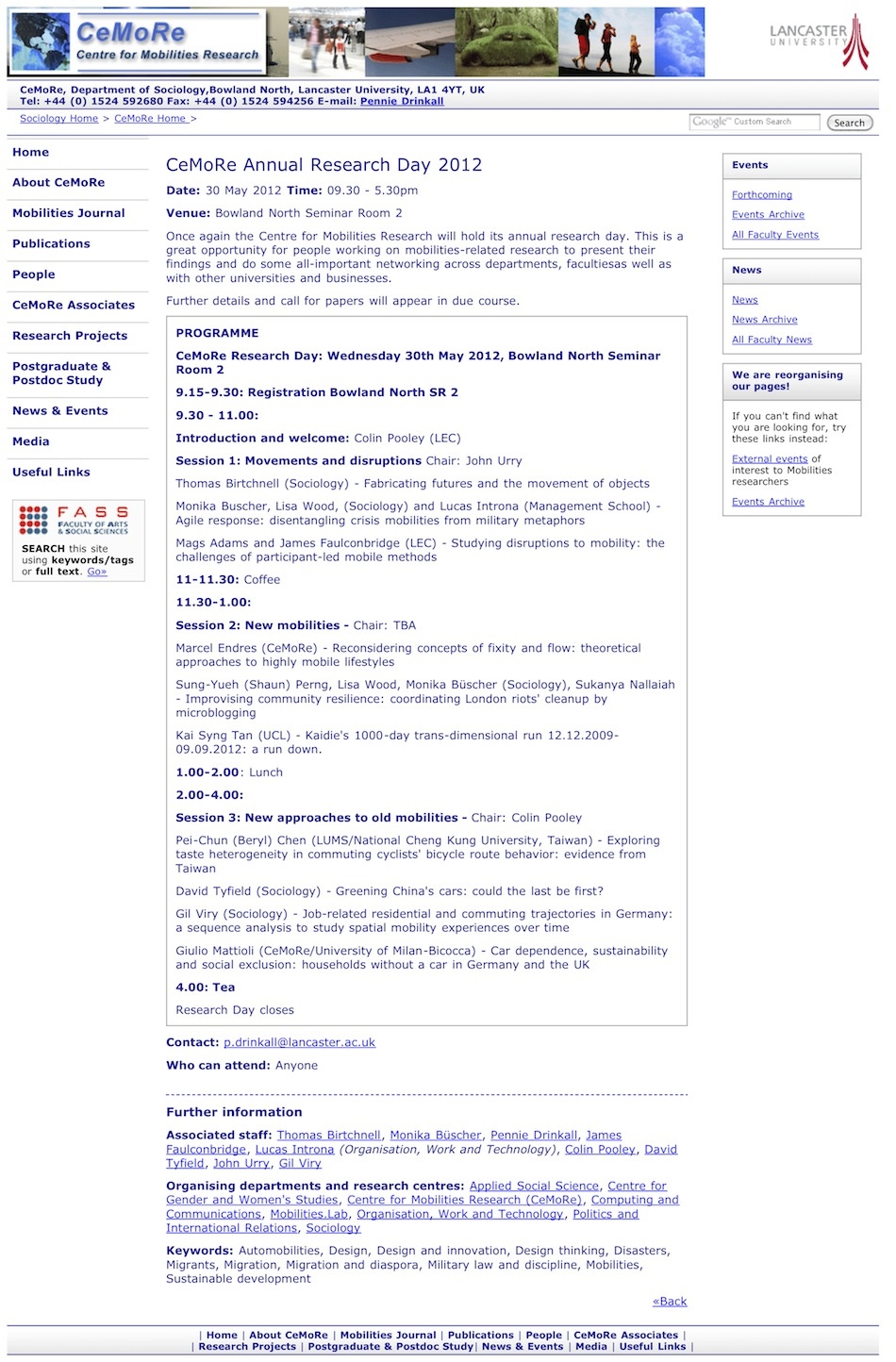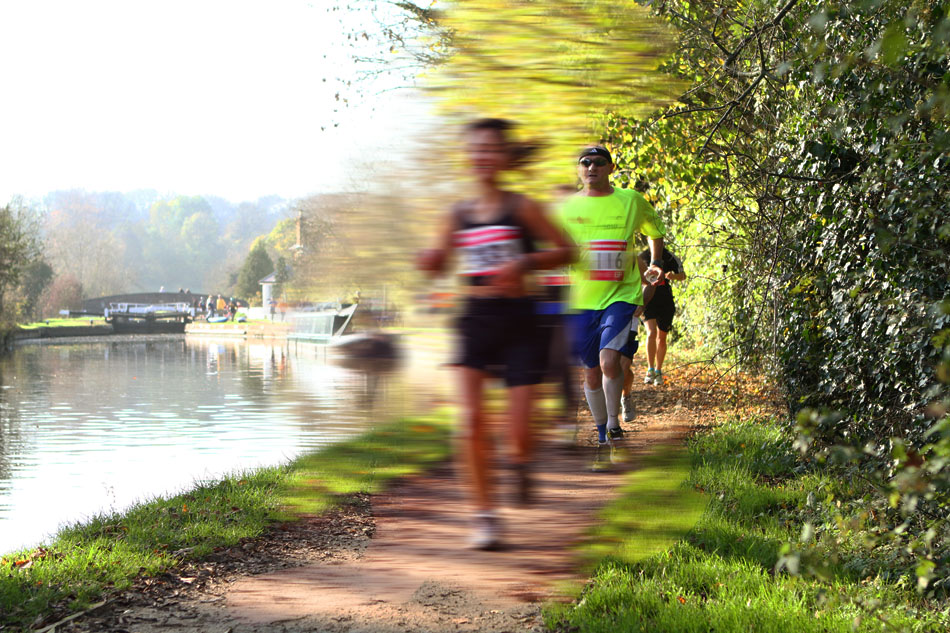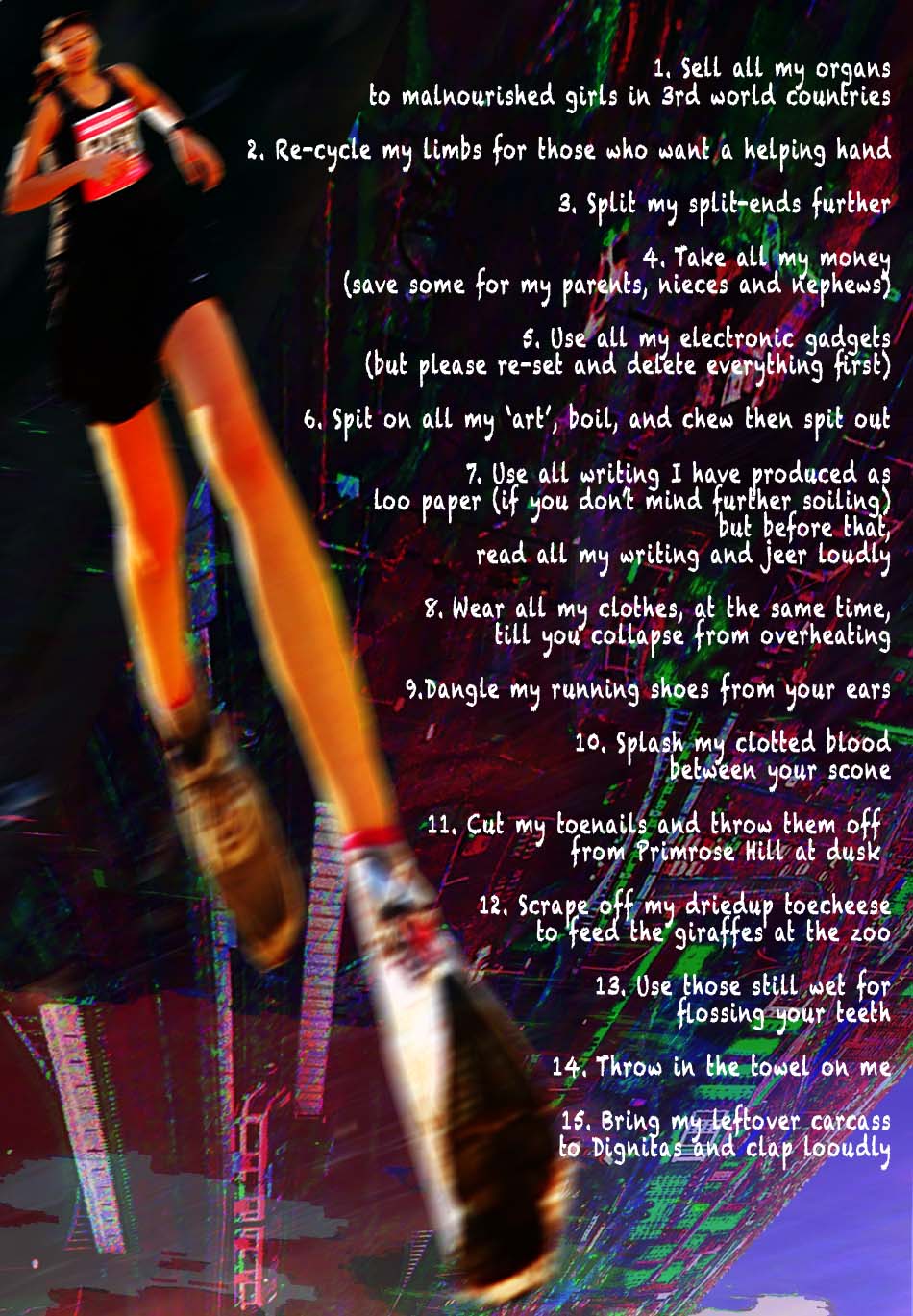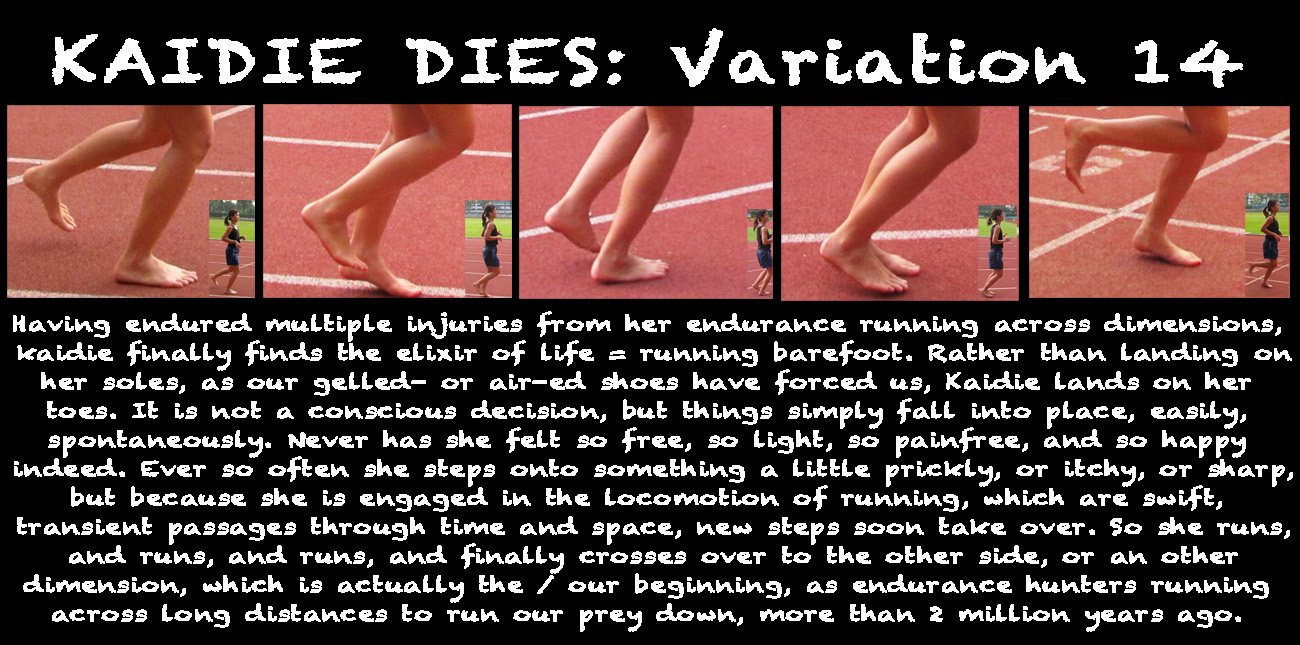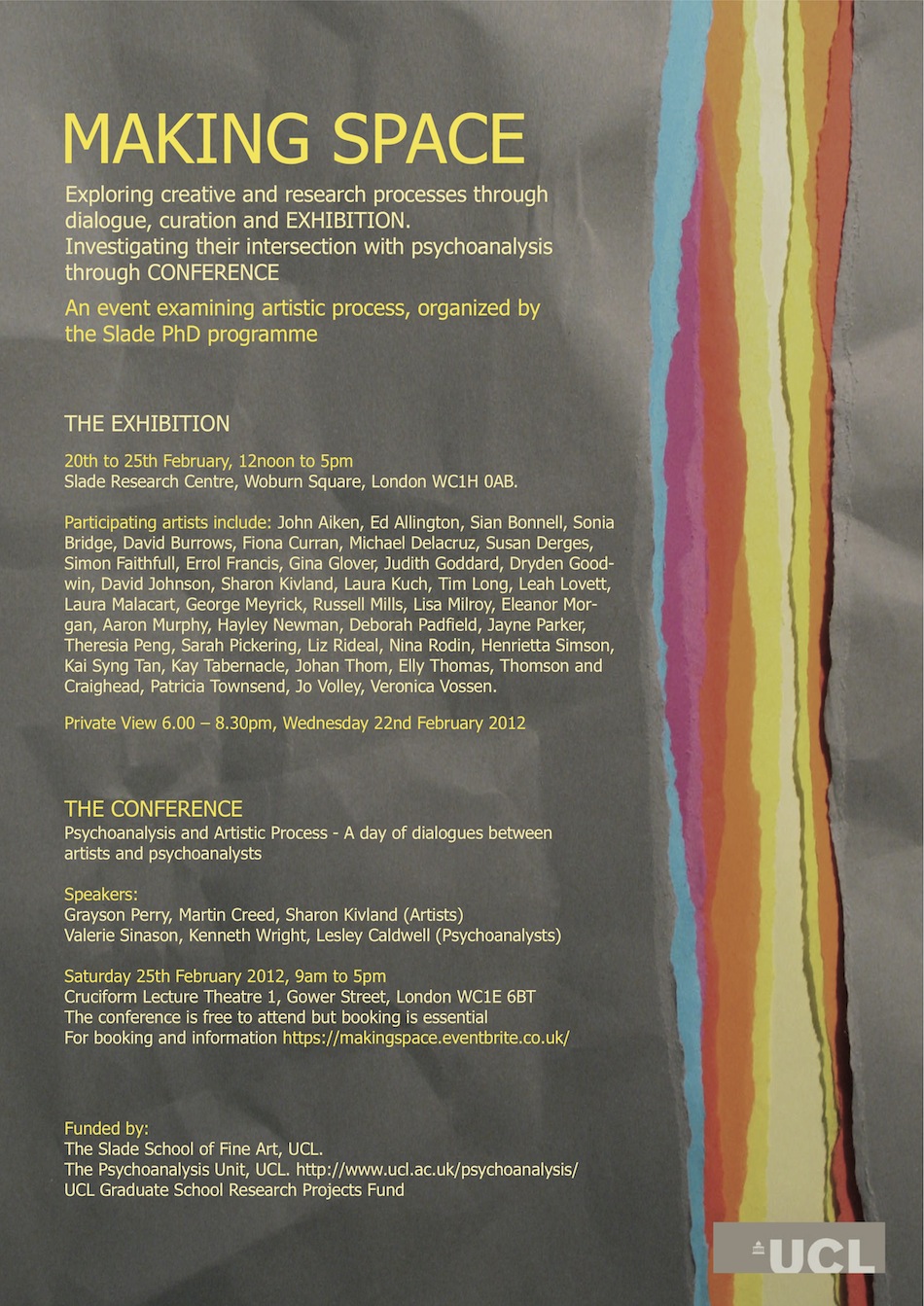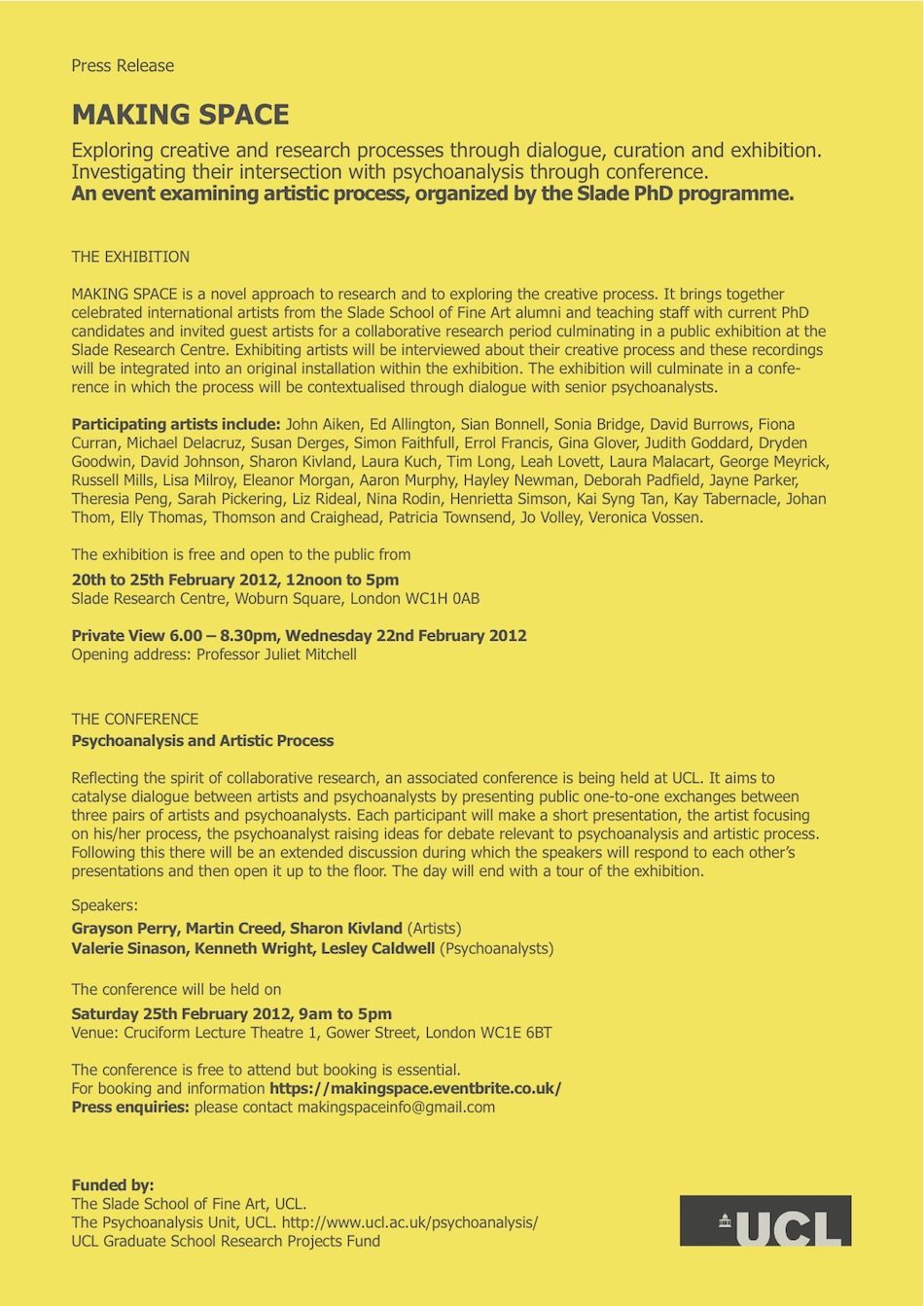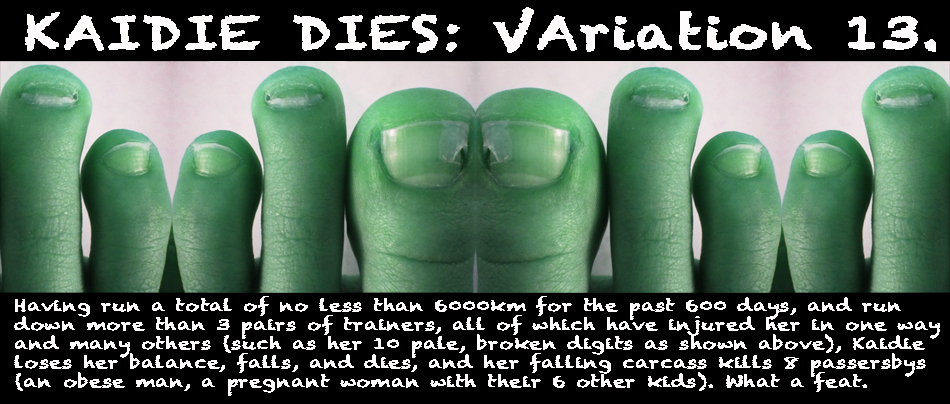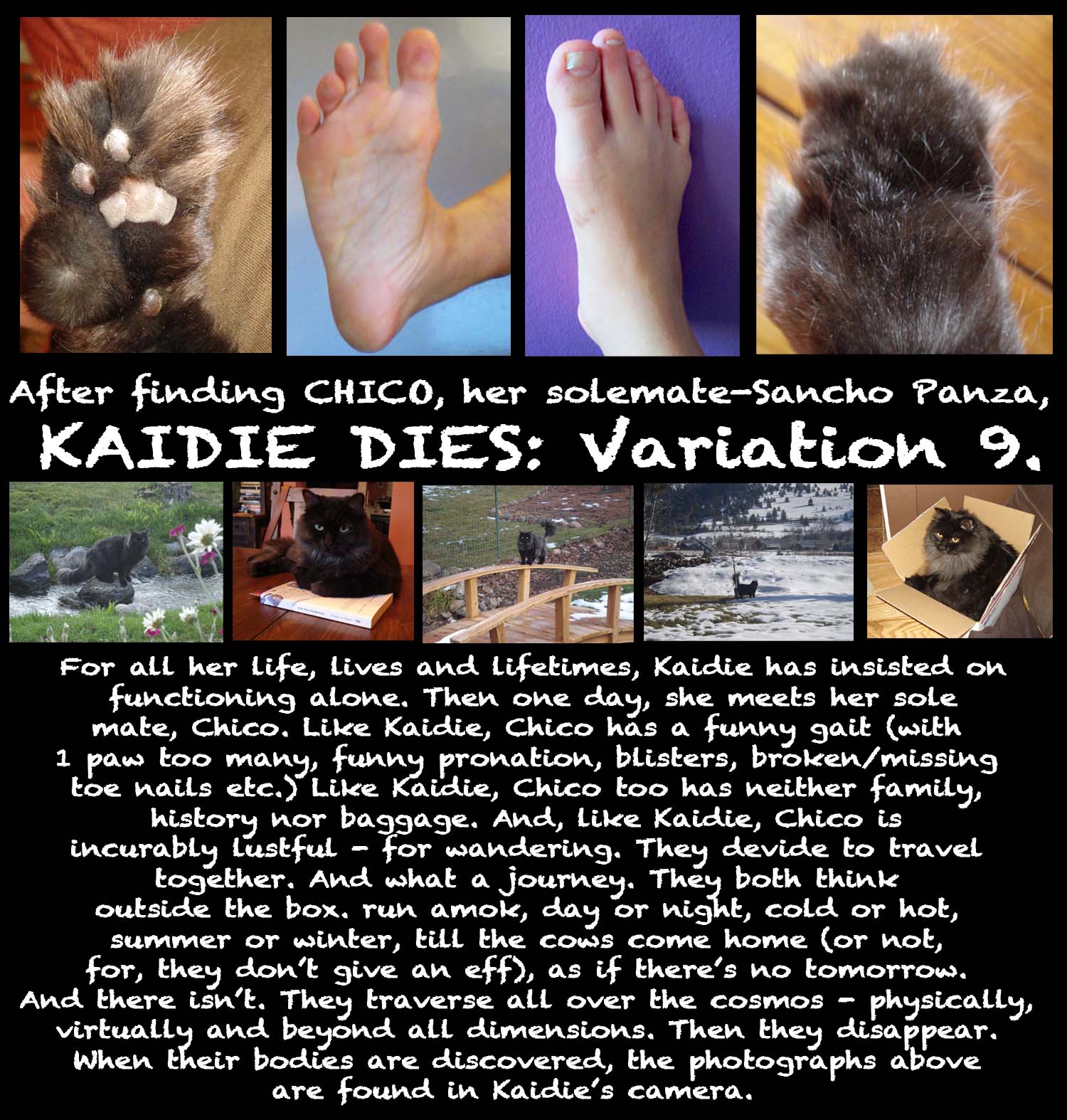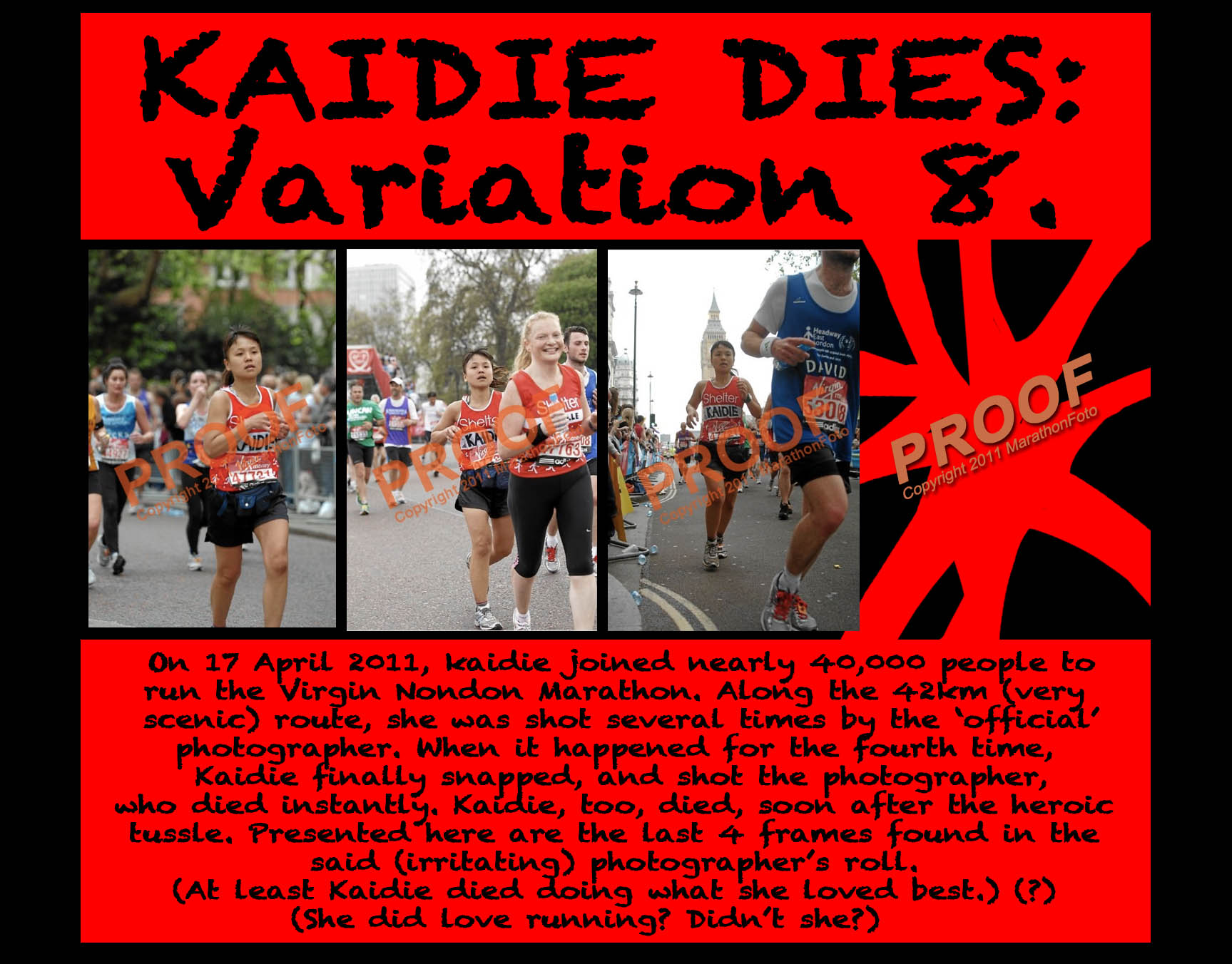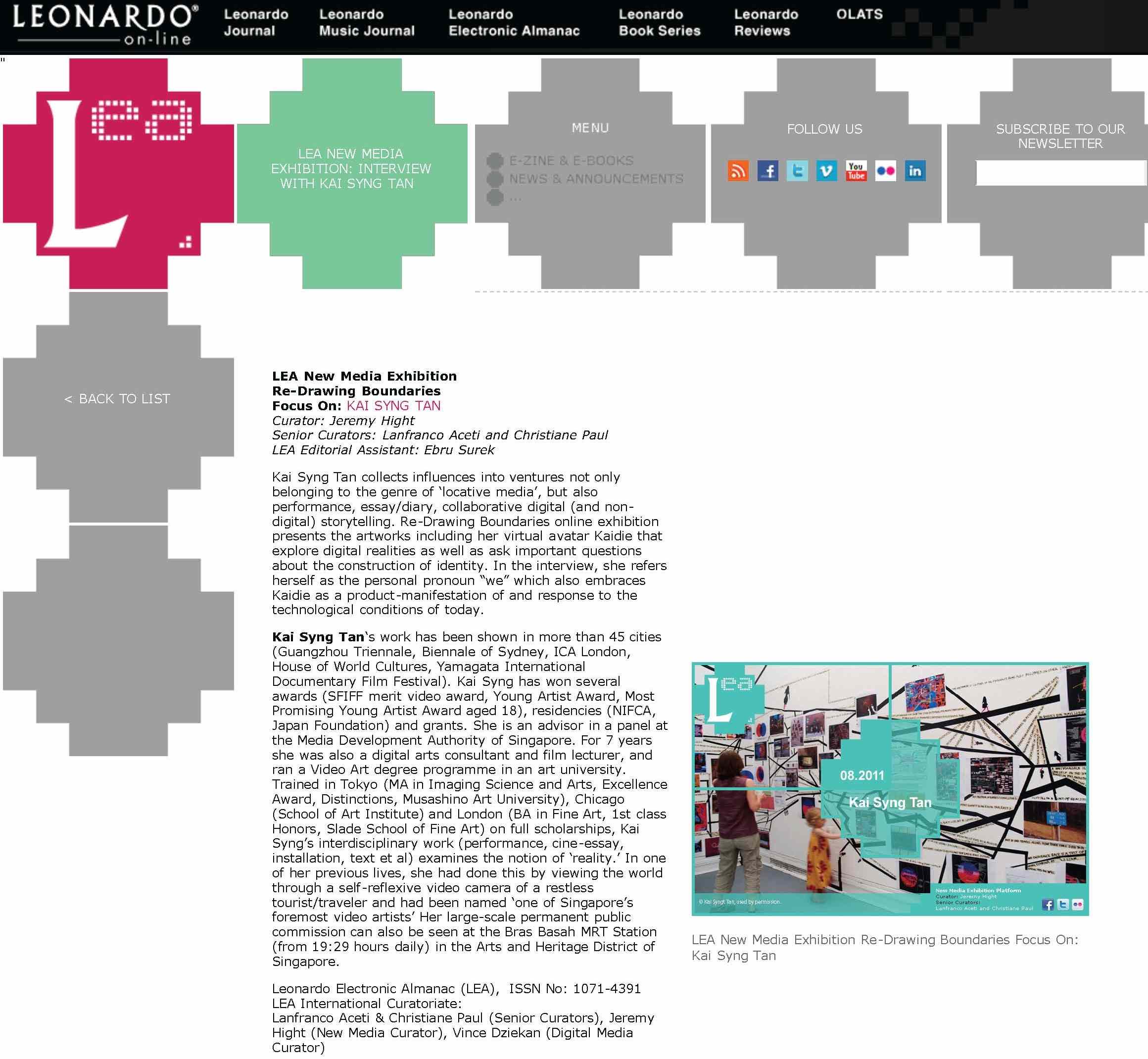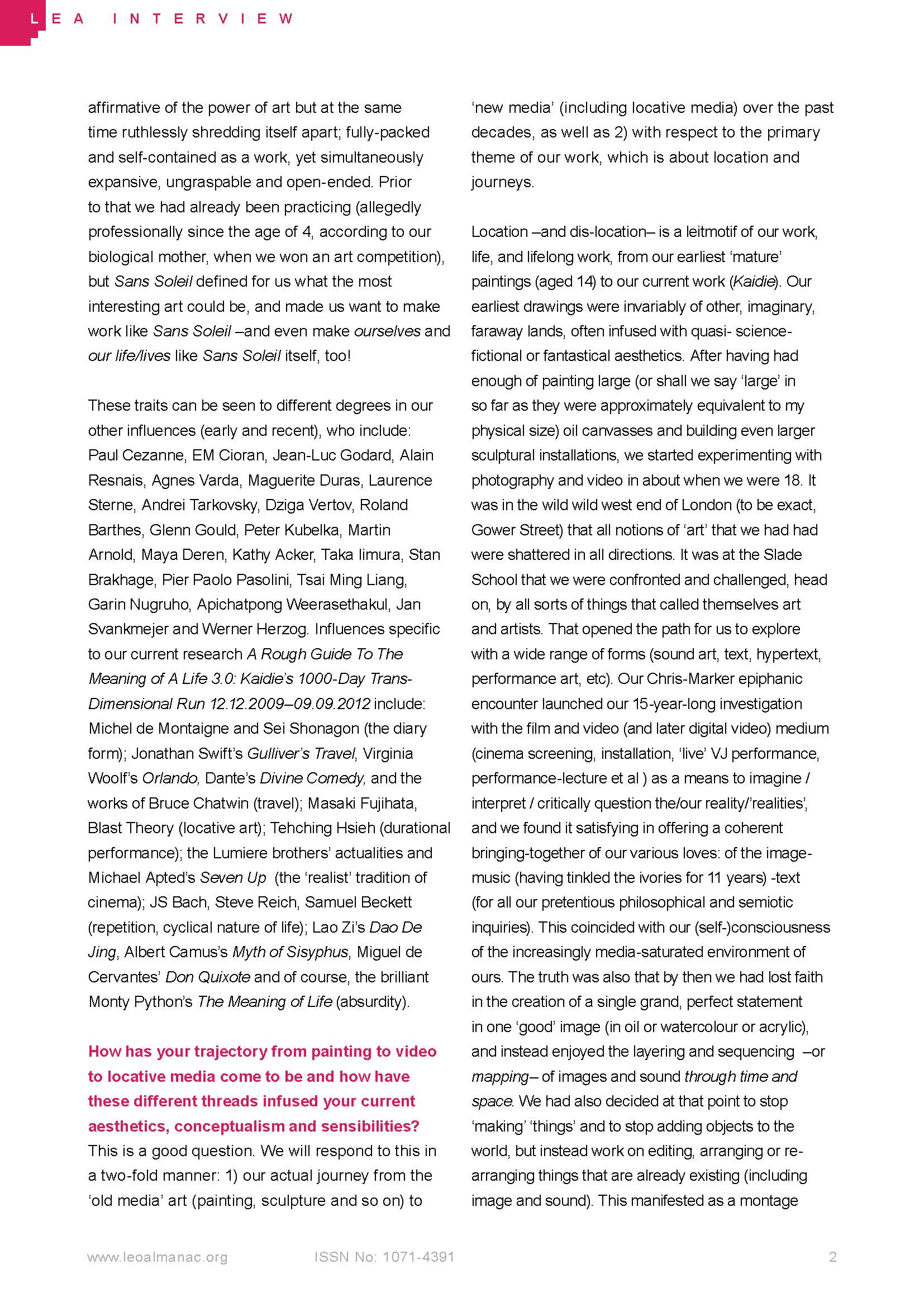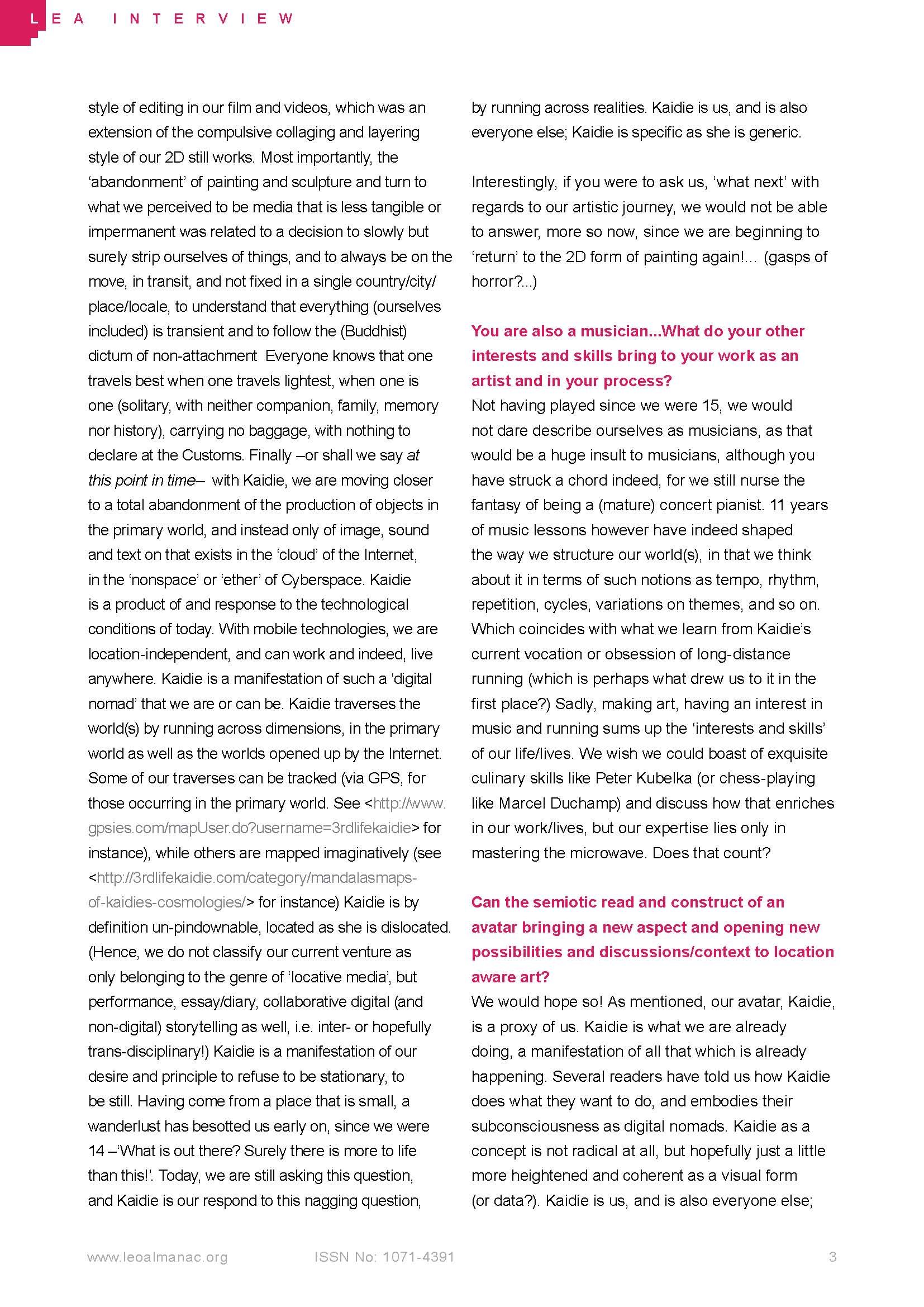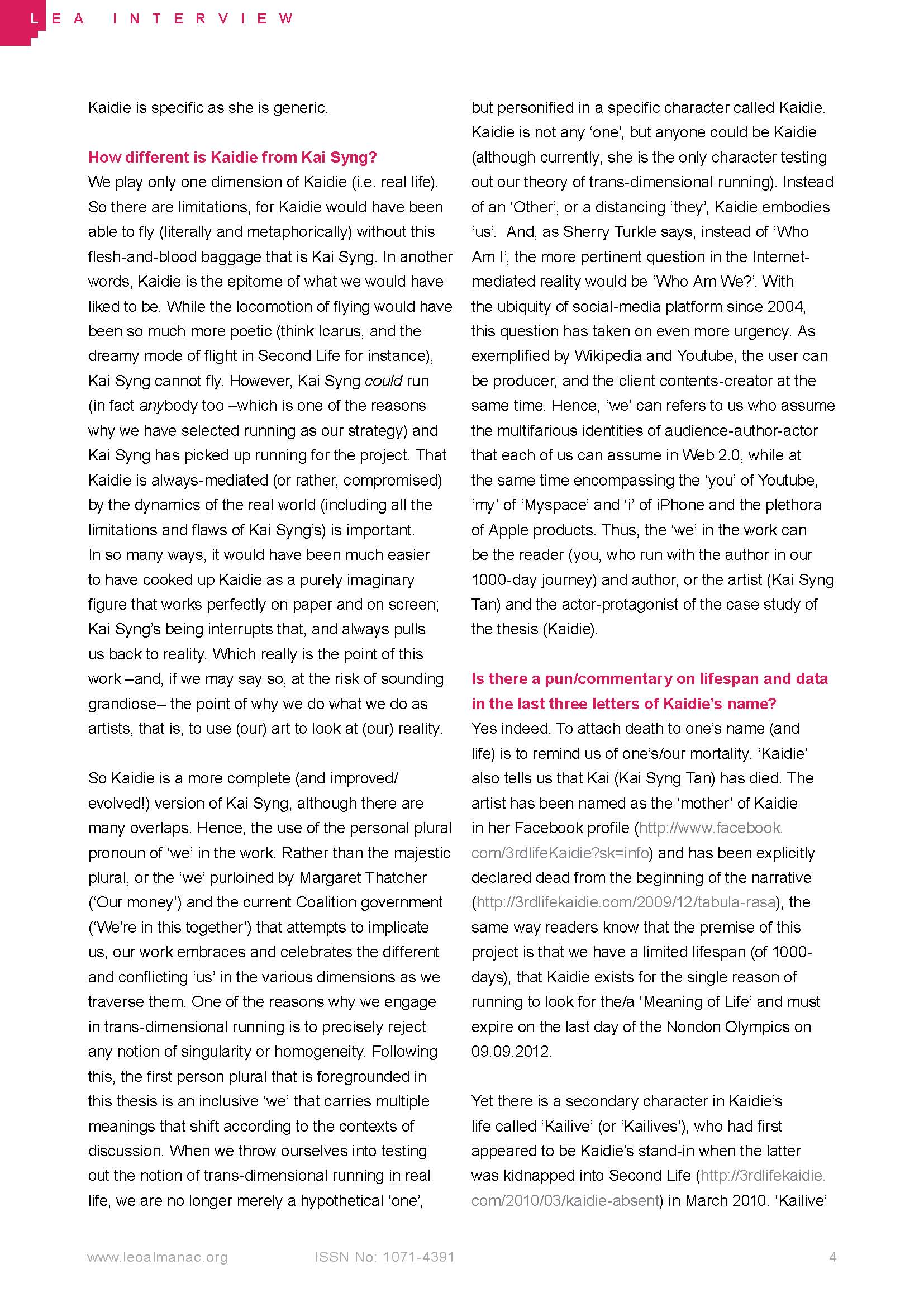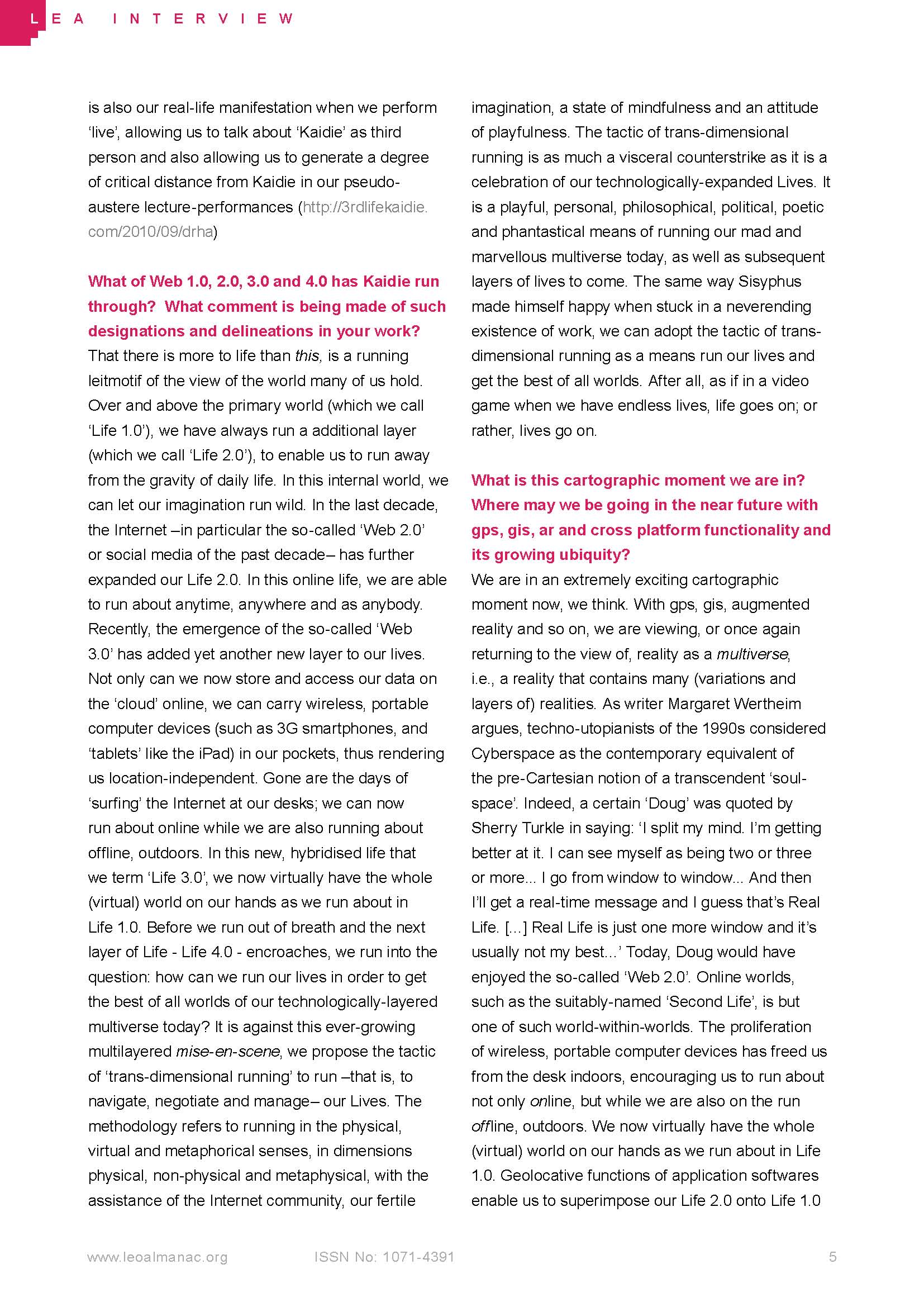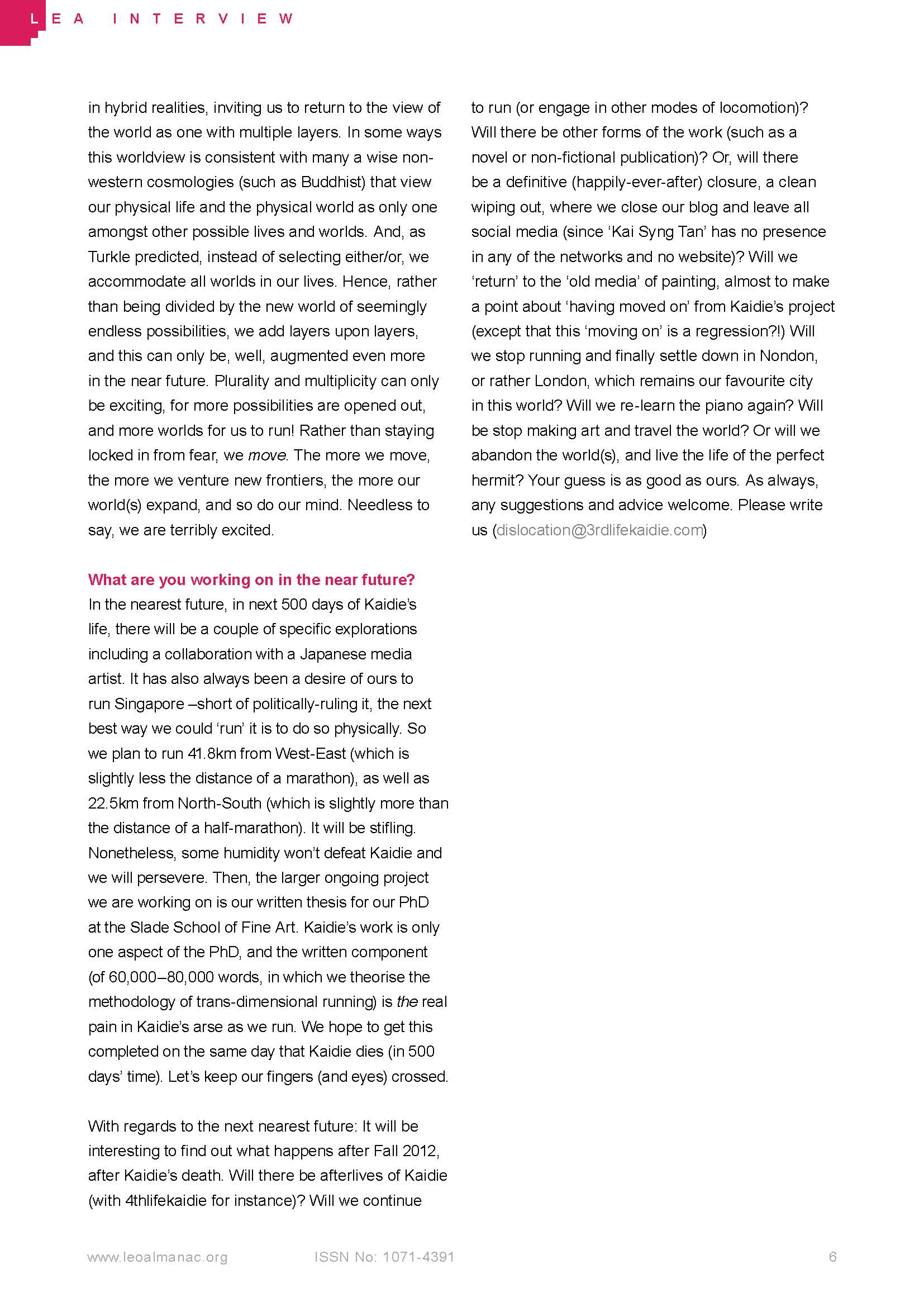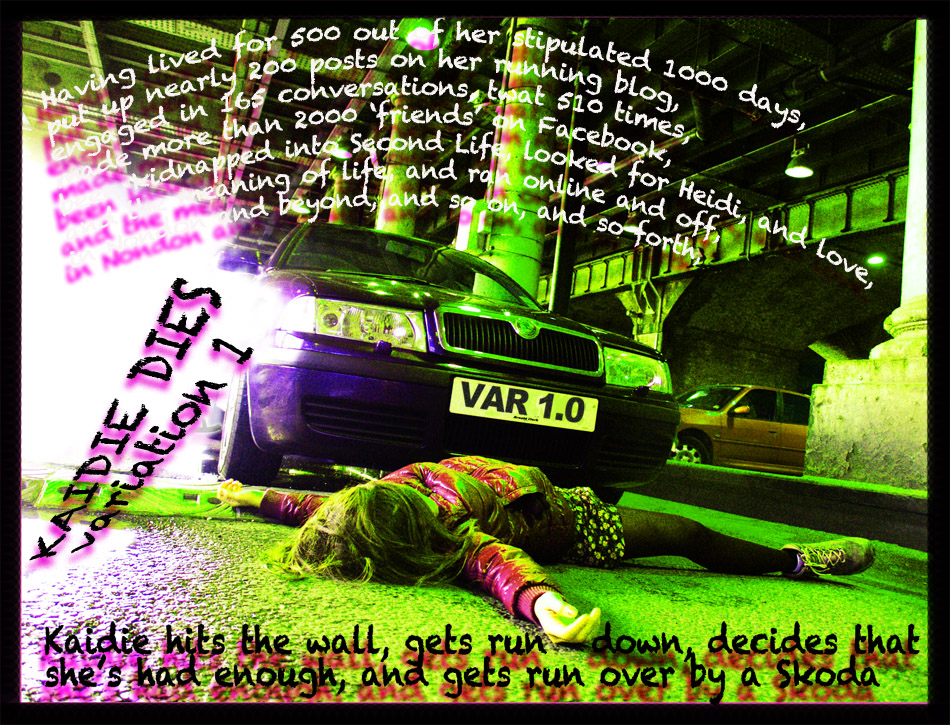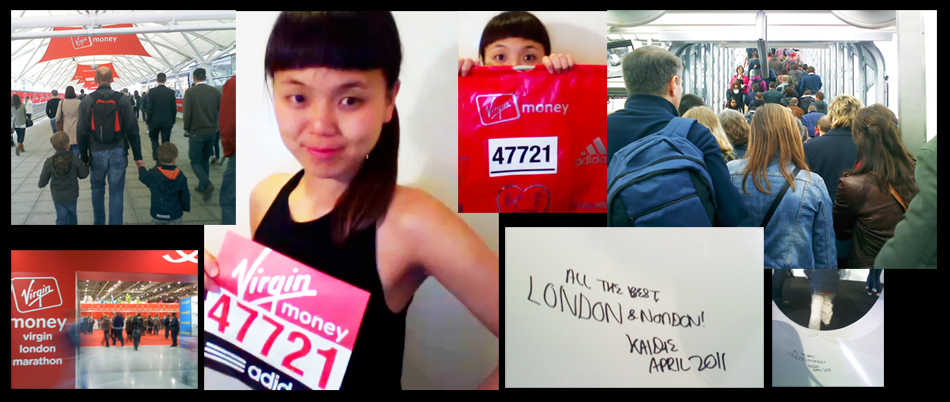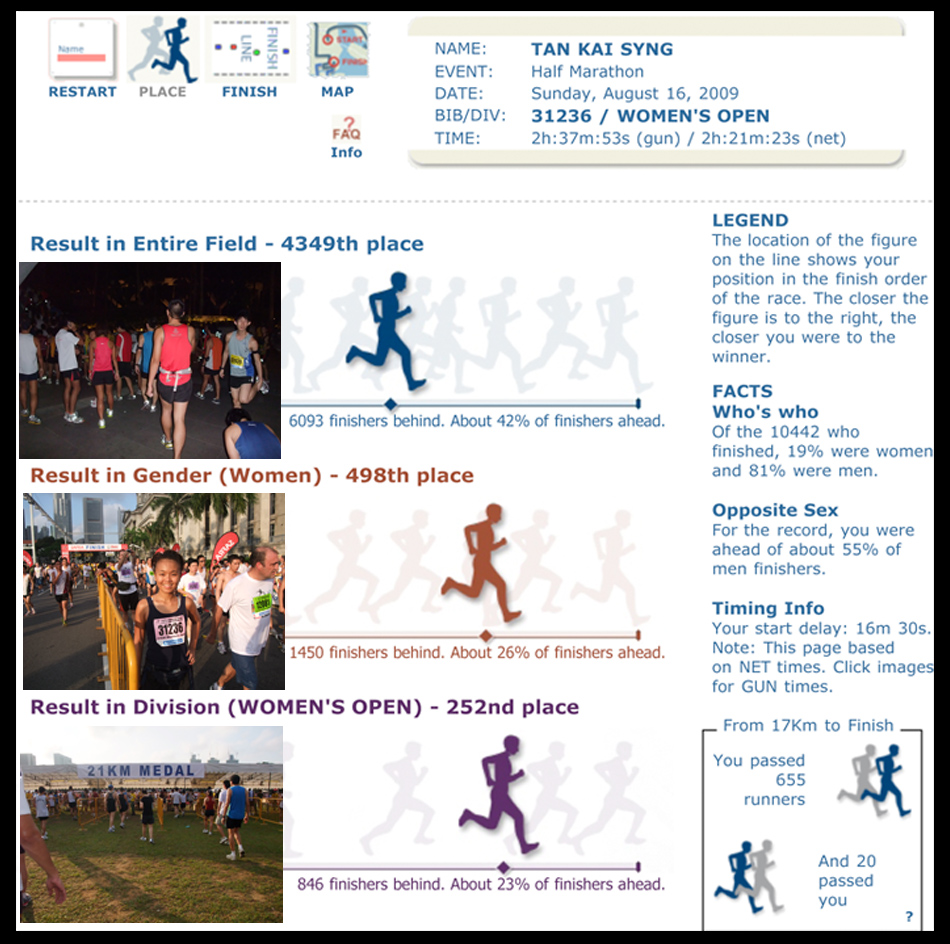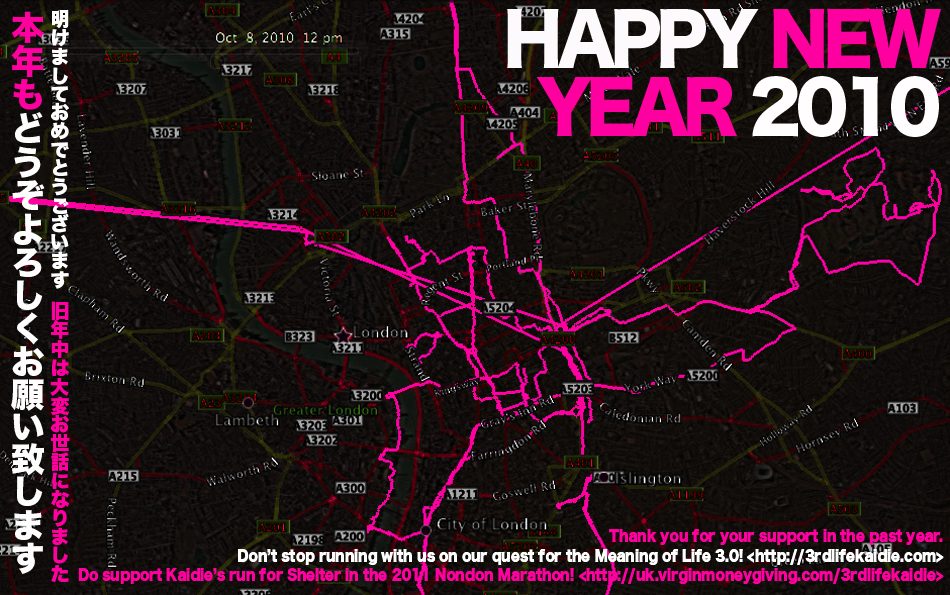**2012 May 30: Recorded version of performance-lecture at the Centre for Mobilities Research, Lancaster University**
This is a recorded version of a performance-lecture presented at the Lancaster University’s Sociology department’s for Centre for Mobilities Research Annual Research Day, 30 May 2012. Present at the session was the Distinguished Professor John Urry. Professor Monica Buscher made 3 inspiring presentations. The conference was hosted by the wonderful Professor Colin Pooley. Music, as usual, by the indefatigable longtime collaborator Philip Tan.
KAIDIE TRANS-MIGRATING? 5
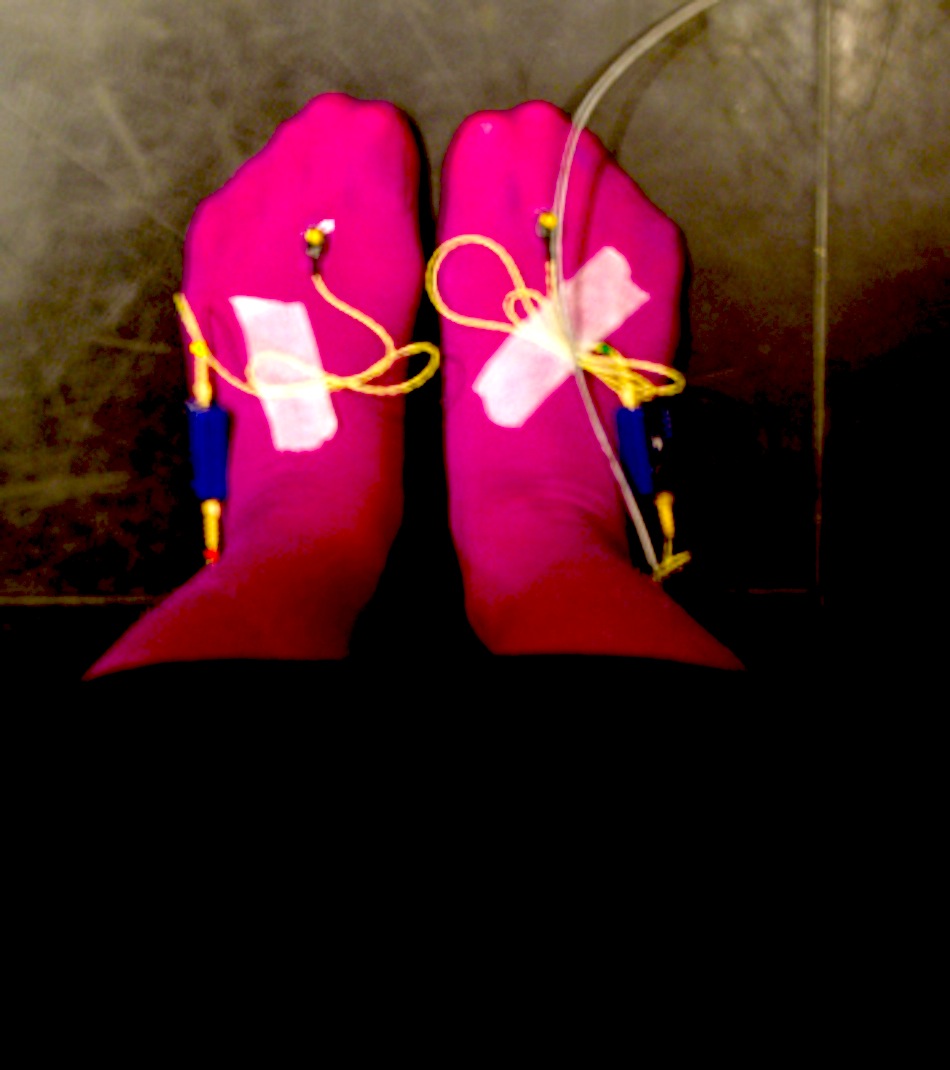
Cabled-up, taken a deep breath, pink-socked, wobbled, ready to take off, to re-turn, to life, on earth. Thummmmpppppppppppppppppppplunginggggggggggggggggggggfreefalling.................. (tbc)
If Kaidie comes back from her death and performs in front of SOCIOLOGISTS, who will be more scared?? Who will run off first?
- This page has been plagiarised from the Lancaster University’s Centre for Mobilities Research’s (CeMoRe) site which you should visit, especially if you can’t come and join us in the scary affair.
** The Creative Process of Running: A 22-minute Discourse (2012 January 25) ** (Happy deathday, 1 year on)
This is a 22-minute discourse on how the process of running – physically and metaphorically – can be creative.
Several of the points in the first part of this work (on how running physically can be creative) have been inspired by the points raised by Dr Alan Latham in his lecture The Zen of Running. You can learn more about the geographer – and hardcore runner – here.
A presentation of this as a slide show was first held on 2012 January 25 at the Slade School of Fine Art, University College London, and exhibited as a video at the Making Space PhD exhibition at the Slade Research Centre at the Woburn Square, February 2012. As with all uploads, this is an ongoing research and subject to change. For more of such inconclusive ‘moving images’, run to Kaidie’s channel.
** You are invited to the Private View of the Making Space Exhibition 22 February 6-8:30pm WC1H 0AB**
While Kaidie remains dead, she may well conjure up a thing or two at this annual PhD event at the Slade School of Fine Art’s Research Centre in Nondon, UK. In any case, many other artists are involved in this exhibition Making Space, including a few big names. You are invited to the PV on the 22nd, and if you have already acquired tickets for the conference on the 25th, count yourself very lucky. The rather delightful Grayson Perry will be speaking – having caught his very wonderful exhibition at the British Museum recently, coming face to face with the great Perry may well be the impetus for Kaidie to stop playing dead and come back to life.
KAIDIE DIES: Variation 9. Rest in Peace Chico! Carry on running.
We also found a note, that says ‘Many, many thanks to ANJI REYNER, Kaidie’s Facebook friend, for Chico’.
** KAIDIE MOMENTARILY RISES FROM HER GRAVE ON 1 AUGUST 2011 IN LIFE 2.0 ON LEONARDO ONLINE **
Kaidie has been momentarily woken up from her ongoing death on 1 August, with her participation in Re-drawing Boundaries, a LEA New Media Exhibition online. And it is completely the fault of curator-artist-writer-theorist-photographer-musician-weathernerd-cat-dad-all-rounded-all-rounder Jeremy Hight (whom Kaidie is acquainted with only via the evil Facebook). Hight’s senior conspirators are Lanfranco Aceti and Christiane Paul. Do visit the show and experience other locative media works by Teri Reub, Jeremy Wood amongst others! Kaidie thanks Hight, Aceti and Paul, and returns to her astral journeys.
KAIDIE DIES: Variation 1.
On Sunday 4/24, a day of Easter bunnies & the resurrection of a popular figure, Kaidie’s 500th-day birthday, Kai Syng Tan’s 36th-year birthday in the external world, but 37th-year birthday including her time as an embryo, which would be the way a person of the Dao calculates it, and 4/24/37 was the time Kaidie ended the 2011 Nondon Marathon, like a bunny caught in headlights, this being the year of the bunny, being Kaidie’s rear, runny bunny, sunny runny, funny bunny gunny hunny etc. Photograph by ‘Trespasser’ on his mobile phone after he ran Kaidie over on this Skoda.
THANKS TO YOUR AMAZZZING SUPPORT, WE RAISED £1520 FOR SHELTER AND COMPLETED THE 2011 NONDON MARATHON IN 4Hours 24Mins 37secs WITH A PLACE POSITION OF 2132.
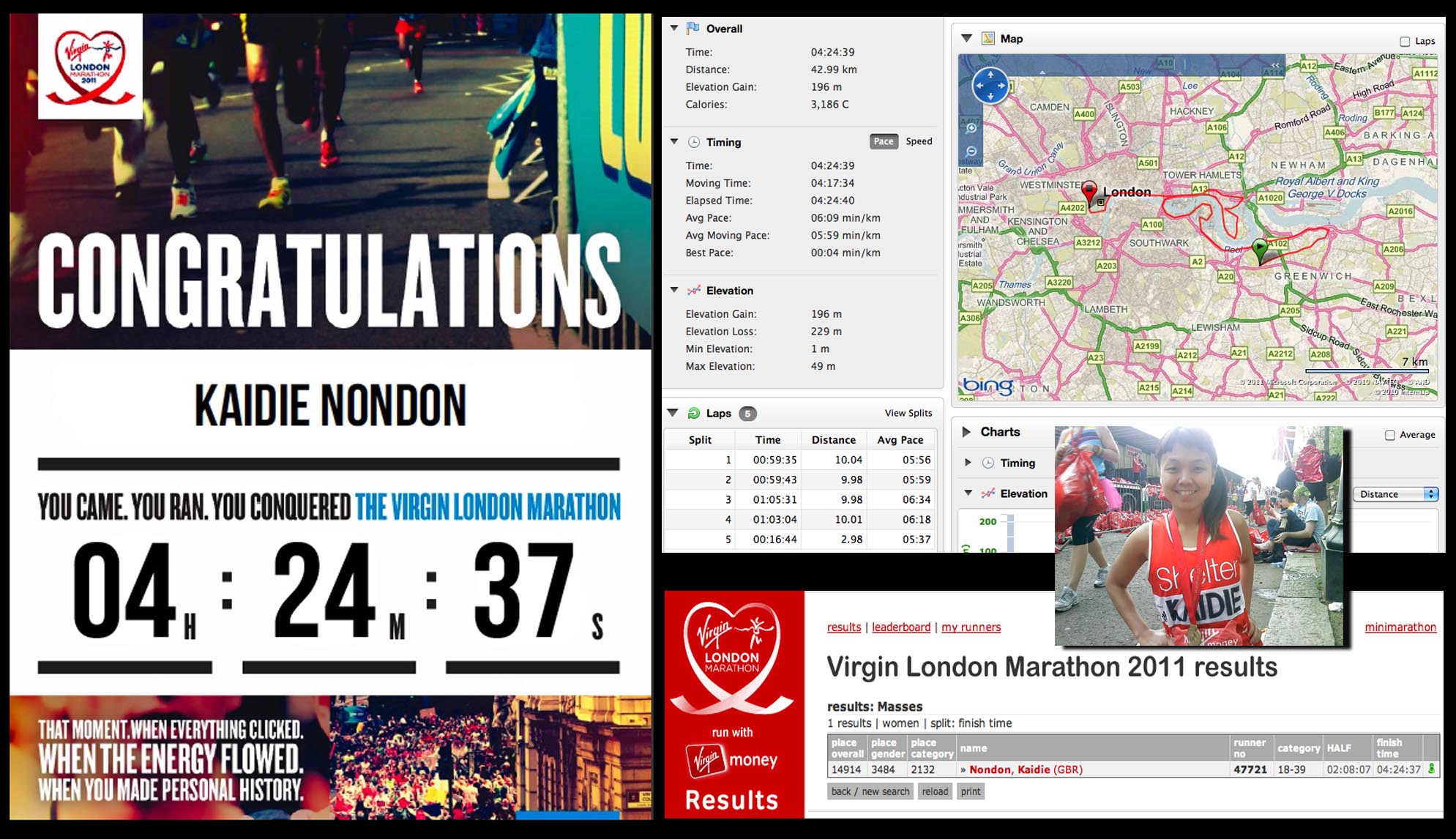
Click image to zoom in. Yes, our name on our vest RAN. Moral of our story: DON'T buy fat marker pens that say 'permanent' and 'water-resistant' from Paperchase. They lie.
An open letter to the 47 sponsors of Kaidie’s run for Shelter at the 2011 Nondon Marathon:
Dear Trespasser, Benson, Emmanuel, Wee San, Zadoc, Andy, Umi, Anonymous, Hapless, Veronica, Ateen, Sarah, Chin Hwee, Kelvin, Caroline, Paul, Chris, Michael, Michael, Anonymous, Tim, Marc, Ying Yan, Anonymous, Shea, Laura, Sze Wee, Mirabelle, Christina, Daniel, Yentri, Stephen, Cristian, Diego, Cliff, Laura, Andrew, Sonia, Fernando, Patricia, Kian Chow, Eric, Pei Chi, Hillary, Pei Shan, ‘Your favourite Russian’, and Ben,
Who doesn’t have nights of tossing and turning, flossing and gurning, cold sweat and stiff muscles, sharp pain racing through the knees, swollen fat feet populated by misshapened black and broken toenails (if you are a foot-fetishist, you’re advised to NOT date a runner, or, if you insist on dating runners, you’d better develop other healthier fetishes) and absolutely-not-wanting-to-get-out-of-bed, especially when it is grey and cold, slippery and murky? We do too, and certainly did, but YOUR financial blackmail left us with no choice but to get up on our hefty-dimpled-cellulited- very-very-reluctant arse, and run. Afterall what’s a wee bit of cajoling our toes to stepstepstep on the pavement one step at a time (typical conversation with our toes and feet: ‘Please??? Prettttyyyyyy puuuulllleaasse!?!!! OH GET ON WITH IT WON’T YOU!’), compared to what people without a shelter have to face and live, day in, day out? Trans-dimensional runners as we are (which is our task for the 1000-days of our existence), running is the least we can do, to help raise money for Shelter for its meaningful fight against homelessness and poor housing in the UK.
So, with your generous support, we raised a total of GBP £1520, and on 17 April 2011, had the honour to participate in one of the biggest gigs on earth on our favourite city on earth, the 2011 Nondon Marathon. At a sweltering 16 degrees celsius, we completed the 42km course in 4 hours 24 minutes 37 seconds (which is 1 hour 5 minutes less than the time we took for our first full marathon last year in the hilly offroad course at the very very lovely Farnham Pilgrims’ Marathon, with battered shins), measured on our Garmin Forerunner 405 loaned to us by Urbantick. We are ranked 3484 in a total of 12,229 (lycra-clad and dimpled) female participants, and an WHOPPING 14,914 overall (of a total of 34,656 male, female and other-gendered participants)! Our position for our category (aged 18-39, although we are only 500 days-old in reality) is 2132.
Given that it was a flat route, it felt easy and not sluggish, generally-speaking. The crowd was wonderful, with people shouting our (DIY-marker-penned-NON-water-resistant) name to support us along the route (one girl shouted: ‘Shelter lady! Looking good!’ We shouted – presuming it was us she was referring to??? – ‘Thanks! You don’t look too bad yourself!’), as well as feeding us with jelly babies, oranges, chopped bananas, home-baked cookies and cakes, chocolates and other candies. There were even 2 priests who sprayed holy water (we presume? or some other unidentified liquid) at runners (which we went for and basked in, non-believers as we are, although always opportunistic for a bonus)! Memorable too was a (drunk?) man who positioned himself at the kerb and held out a large plate of CHIPS goading us ‘GO ON, YOU KNOW YOU WANT SOME CARBS!’) We also slapped the extended hands of several kids (SOME OF WHOSE LOOKED REALLY FILTHY!!! What had they been handling!? Eeeeewwwwwww) as well as a couple of adults (Eeeeeewwwwww!). For the first half we kept up at a good speed, and the first 2 ten-kms were completed around 60 minutes, while the last 2 took a little longer, as we worked-in a timeout/lull session, before we went for a faster final 2km (of the 42km route). Our time at half-marathon distance (13.1 miles) read 2 hours 08 minutes (which is 20 minutes faster than our first attempt in a half-marathon in a previous life; we are hence now certain that a next half-marathon can be completed in around 1 hour 55 minutes). We burnt a total of 3186 kcals, and did not take any loo breaks (‘So what?’ you may snigger, but a record for our tiny bladder [and oversized brain, as you our dear reader are well aware]). We ran as a ‘GBR’ person (instead of ‘SIN’), not to mention the ‘Virgin’ (and ‘Money’) tag all over us… It felt HOT HOT HOT for us – imagine what the fancy-costumers had to endure!!! We kept running into one of the Rhinos- and we had read that their costume was more than 18kg. Not one time did that Rhino, or many of the other costumed runners, stopped. They got on with it, step by step. Seeing that, we switched off our pain button for our supercramps that had haunted us the entire week, and got on with it.
What spurred us during the course? 1) Our anger at the enforced feeding and reduced training in the past week (as advised by ‘experts’: ‘taper and carbo-load!’). For 7 days we were so restless we were completely dysfunctional, not to say insonmiac (fearing that we’d oversleep and miss the gig) and murderous (wanting to slaughter runners we run into, out of pure envy) as well. The forcefeeding -of CARBOHYDRATES, NO LESS!- was most unpleasant and traumatic. 2) We found the sight of other wobbly, thunderous cellulite-cum-dimples in hips wider than 62-inch-wide plasma-TV sets IN LYCRA slightly offensive. AND THERE WERE MILLIONS, UNABASHED. Also to spare runners behind us of THEIR eyesore of OUR cellulited plasma TVs (although we were wearing shorts, NOT lycra), we huffed and puffed and kept moving. Like jellies. And the godmother of jelly, baby.
After the race, we attended the party thrown for us by Shelter at the Strand. We enjoyed a most lovely massage given to us by a most lovely Phil (who told us that he was a ‘functional therapist’. ‘As opposed to a dysfunctional one?’, we asked; Phil also said that our ‘IT band’ was tight. Techhy as we are, we are proud to hear that a band – an information-technological one, no less, inhabits our body), had a few glasses of prosecco (of course we would have preferred Champagne, but darling, it’s alright, as we do love bubbles), as well as linguini WITH FOUR meatballs (The race has brought out the carnivore in us!!! The waiter gave us 6 but we donated 2 back. ‘Are you sure??’ ‘YES!’ we cried, and threw his balls back at him, while we rolled ourselves back to our seat)!!! (All these benefits of our £100 entry fee!)
What did we do when we went home? Watch the BBC’s coverage of the event on iPlayer, of course. It is always always moving to watch endurance athletes do their thing. The show put up by this year’s winners was, to say the least, incredible. They were not running 42km – THEY WERE SPRINTING. Those large long strides – powered by their tiny, leanmeanmighty bodies. So you think that only us mortals suffer? As soon as the elegant Emmanuel Mutai came home through the finishers’ line, he stooped, to puke. Bright, yellow, stuffs. Who would have guessed? For, like fellow Kenyan and female champion Mary Keitany, his was a face of resilience and pure focus, from beginning to end. He held court, and got on with it, and won – gracefully. TALK ABOUT ENDURANCE.
After a day of rest and unsettling sleep (pierced intermittently by foreign pains in our knees – and IT bands????), we resumed running (we mean limping) on Tuesday. We have also signed up for 2 races: the Kilomathon (26.2km – YES in our favourite METRIC system!!) on 23 October 2011 in Nondon, and the Bath Half Marathon (21km, or 13 miles) in March 2012. We do enjoy the full slap of 42km / 26 miles, but we think that the twenties are the most suitable. Afterall, we do not have all that much time left in our 1000-day lifespan for hours and hours of training, and we still need to run not only in Life 1.0 (in the primary world), but Life 2.0 (online) as well. We intend to go for a couple more within our lifetime: a warm one, during Winter (Marakkech!) and a midnight sun run (in Norway! Aha!).
All in all, the 2011 Nondon Marathon was a pleasant race. We were fully focused on our given task – the task that you have entrusted us!! We feel honoured and humbled to have been given the chance to run such a big gig in our favourite city on earth, and to have done so for a meaningful cause. THANK YOU to all our sponsors for your generous support for our donation drive for Shelter!!! THANK YOU ALL for your lovely messages of support!
Yours Sincerely,
Kaidie x
PS For our other readers reading this, should you wish to show your support for Shelter, YOU CAN STILL MAKE A DONATION! Click a few clicks here!!
PPS: Dear ‘Trespasser’, if you are reading this, please write us to tell us who you are, for, how could we possibly thank you properly if you do not reveal yourself?
WE JOIN 40,000 TO RUN THE 2011 NONDON MARATHON ON SUNDAY! But NO, THIS IS NOT A RICHARD-BRANSON PRODUCT-PLACEMENT BLOG POST!
1) Running is an immensely popular sport today all over the world, since it can be done anytime, anywhere, and by nearly anybody. 2) Any marathon is a big gig/performance/show (a show of human determination, although nowadays marathons, and even triathlons is such an achievable feat that the genuinely fit ones go for and invent ever more ultra- and extreme races, in impossible landscapes, over impossible periods of time, etc, etc. 4) Nondon is an amazing stage to live/work/play/be (we’ve gone through this before) 5) The Nondon Marathon is a big show on earth alright (Biggest fundraising event on earth! 40,000 runners! Records to be broken The most scenic marathon routes! … …) 6) Nothing – no thing in this world today escapes the supermarket, corporatised treatment/makeover. 7) Richard Branson has never, ever been known to be subtle.
HENCE. Look at these images. Richard Branson’s Virgin has been running the Nondon Marathon in the past years. It’s a huge gig alright – a large advertisement for itself. Yes, do yell it loud and clear, in every which way possible, leftrightcentre, brand us and co-opt us into your game, your rules. Thanks Sir Richard. If the Nondon Marathon Expo at the Excel Centre (MILLIONS OF FIT [healthy] AND FIT [goodlooking] runners, lean and mean and powerpacked in lycra!) is just a small indication of what’s to come on Sunday 17 April at the Nondon Marathon, we are prepared to be even more branded (‘Virgin’ no less!), and be seen with even more products. ‘Pure’ as it is or can be, running, like any other activity today, can be coated in much gunk that threaten to make us forget why we run. (We are not being cynical and dismissing the good work that such a big gig does (raising much fund for charities for one, and we are running for a charity as well), but there are always questions to ask in any such large-scale hyped-up enterprises [Bono, Geldof et al]). It does not have to be like this- our last (and first!) marathon was a much smaller event. The Farnham Pilgrims Marathon in Surrey was quirky and intimate, highly praised by all runners of varying experiences, and was not dunked in excessive institutionalised/corporatised distractions. We have signed up for the Bath Half Marathon in March 2012 (provided if we live till then?), but there are certainly questions to be asked and issues to think about, with regards to the institutionalisation of running – an activity that is, for us, essentially an act of gentle anarchism, a personal act of resistance. It’s an interesting tension. In this day and age no one is not co-opted in one way or another, but the question, we suppose, is how we run (navigate, negotiate, manage) that tension (like we do many things in life, unless we are hermits living in caves). Before we become (hairy/smelly) hermits in caves, we scribble a message on the wall at the Expo. (Thanks ADIDAS!!!!)
UPDATE: THANKS TO MS CHUN WEE SAN, WE HAVE HIT OUR TARGET DONATION OF £1500! This is Wee San’s SECOND donation for our Nondon Marathon effort for Shelter, the homelessness charity! Wee San, an art teacher, has previously also supported our run for the Friends of Medecin Sans Frontieres! THANK YOU WEE SAN! We also want to thank Jackie Claxton for her support, even after we have reached our target! Having reached our target, we have slightly raised the bar to £1600, so keep your donations coming! Click some clicks here to donate, today! We will close our donation page 1 week after the marathon, on 24 April 2011 Sunday.
AFTER WEEKS OF PRE-RACE ANXIETY, SUPERCRAMPS, FORCEFEEDING BUT TAPERING, IRRITABILITY, WE ARE MORE THAN READY FOR OUR RUN. TO FIND OUT HOW WE HAVE DONE on 17 APRIL 2011 AT THE 2011 NONDON MARATHON, COME BACK TO THIS RUNNING BLOG IN A COUPLE OF DAYS. BUILDING IN 1 LOO BREAK (INCLUDING QUEUING UP – no we won’t do a Paula Radcliffe!) WE ARE HOPING TO COMPLETE OUR 42KM BY WEDNESDAY MORNING, OR, IF WE ARE OPTIMISTIC, TUESDAY EVENING. SEE YOU SOON(ER OR MUCH MUCH MUCH LATER)!
REVERIES OF A SOLITARY RUNNER III: following the footsteps of runner-writer Dr George Sheehan (1975)
The words of Dr George Sheehan resonate deeply in the world of running. Such a cult figure he is that his book titles include his name (not just On Running, but Dr Sheehan On Running, 1975 Bantam). As a (still relatively) new runner, we are beginning to read his work, and do enjoy his discussion of the relationship between running and writing – a topic that cult novelist Haruki Murakami talks at length in his What I Talk About When I Talk About Running. What we wish to highlight in this post is what he says with regards to the loneliness of a long distance runner, which echoes the laments of Rousseau and Qu Yuan in their flights, actual and metaphorical. While we do not agree with everything he says that is quoted here, we like his unapologetic approach, his assertion of his individuality (many [non-runners] will call this selfishness). His defiance and irreverence remind us too of the gentle anarchism of Lao Zi, whose renouncement of court duties and wanderings were tactics of resistance. Interestingly, we note that Sheehan was not quite solitary enough however to not give talk after talk (hence also establishing a cult following) – and to not have fathered not one but TWELVE children, an activity that we know requires more than one (unless there are scientific interventions, of course)…
Page 42:
Runners are solitary and cerebral rebels in silent and meditative protest against our modern ways.
A world composed solely of runners might be unworkable, but a world with them will be unliveable.
Page 44-45
There is a metaphysical lawlessness about running. The runner puts himself above law, above society. He is a law unto himself.
The runner follows no one’s law but his own. He cares for little but the workings of his own mind and body. He would, as one runner told me, rather give up his best friend than give up running. He cares even less for this institutions that protect and support him. He despises authority and, if anything, agrees with Auguste Comte, who wrote that participation in government is fundamentally degrading,
He further alienates those who see the crowd as carnival where everyone joins in, becoming one happy, amorphous glob. The runner is an ascetic. pleasure is painful to him. Singing and dancing and even talking to another human being are avoided at all costs.
When he runs on the roads, he is making a comment about life. He is, in effect, criticising the life-style of everyone who sees him. He may not want to do this, but he does. he is putting down those who smoke and drink and socialize and call everyone by their first name. He has given up on that world and those in it, and has gone inside himself. No wonder those who live by the rules, or live by community, feel threatened by him.
Seen this way, what happens to runners is the just wrath of a society pushed too far. Those who believe we should all be one, as citizens or brothers, see the runner as a loner who never will contribute to the common good. That, they say, is man’s real inhumanity to man. And they may be right. In this world, no one is innocent.
DO YOU WANT TO BE KAIDIE’S FINAL DONOR(S)? HELP US RAISE OUR FINAL £117 FOR SHELTER BEFORE WE RUN THE 2011 NONDON MARATHON NEXT SUNDAY 17 APRIL!
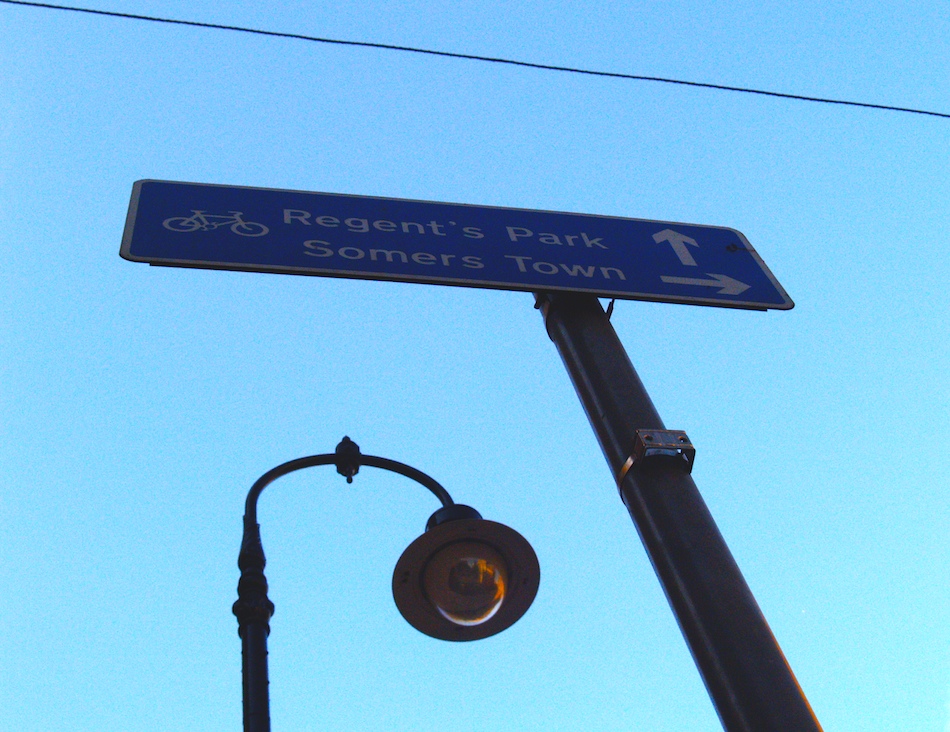
This mind-blowing image will grace Chin Hwee's wall, due to his generous donation. Mercenary, are we? Helping to redistribute wealth? Or merely spreading the immense beauty and poetry of our creative expression to everybody? (You're welcome, our pleasure.) Do YOU want a piece of our astounding art work? Give us £100 - or rather, give SHELTER £100 via us (we pocket NOT one penny), and a unique, signed print is yours. YOURS!!!! Call us now to engage in this meaningful transaction. Don't call us now, and you wil regret it, for our amazing works are not only going way below cost price (ahem) and our market value (ahem) in the art cattle market, the prices of our fabulous works will soarrrr once we kick the bucket (is the bucket half fool or half empty??). Don't live your life with regrets. Act NOW. Help us help Shelter NOW.
THANKS to the generous donation of Tan Chin Hwee, we have raised a grand total of GBP £1383 for Shelter, the homelessness charity!!!!!! This is superb, and beyond our expectation. We are so very chuffed that this money will be put into very meaningful use by the charity that fights against homelessness, an issue that is urgent now more than before due to the recession. THANK YOU to ALL 43 OF YOU WHO HAVE CHIPPED IN TO SUPPORT OUR EFFORT in the past 4 months! A MILLION, BILLION, GAZILLION, MEGAGAGAZILLION THANK YOU, everybody. THANK YOU VERY MUCH TOO ATEEN PATEL for your donation! Ateen is a runner as well, and is running the Paris Marathon in memory of his father, and raising money for the British Cancer Foundation – please do help Ateen if you can! Chin Hwee too is an avid sportsman and has always inspired us in his activities – we had taken part in the SAFRA Army Half Marathon together in a previous life. In spite of his madly punishing schedule at work (including work for the community), today Chin Hwee has resumed running seriously – presumably inspired by us, this time round, this life! Well done us, pats on our backs, ahem – and is taking part in the Singapore Marathon at the end of this year!! GO CHIN HWEE GO!! Chin Hwee has previously also supported our fundraising efforts at the 10km Friends for Medecins Sans Frontieres race, as well as the Farnham Pilgrim’s Marathon when we raised money for the Farnham hospices. We will make a print of the above image to present to Chin Hwee for his wonderful, wonderful support. THANK YOU CHIN HWEE!
With Chin Hwee’s kind donation, we are now tasked to raise the final £117 before our big gig next Sunday. Won’t you help us in our final lap? Please do – a £100 donation gives you a unique, signed print!, but any, any amount is greatly appreciated. With devastating cuts, times are hard, those of us who are able to help in one way or another should, all the more, do so! Mentally and physically we are more than ready (although we have a disgusting patch of bruise/blister field on our right sole – TMI!!!!!!!!), having not stopped running throughout the entire $%£X####X winter, training very very nearly every single day, and frequently defiantly at 6am in the dark around our favourite Regents Fark, to stick two fingers at whoever/whatever creates cold and grey and depressing winters. We look forward to pounding the streets of Nondon. Nondon is our favourite city on earth and beyond, and running through the most spectacular parts of this inspiring and giving metropolis with thousands and thousands of people in one of the biggest shows on earth will be breathtaking, so breathtaking that we may forget to breath and die. We love running alone, but we also love running with masses and masses of people in our most beloved urban stage and playground, this life, and the next, and the next, and the next!!! Come and join in the rave. See you there. (We will be the ones wearing red! And panting with our big fat tongue sticking out! With blister fields on our feet! And not smelling very nice! And flapping our arms wildly! And … … )
ALAS! HAS IT ALL GONE PETE TONG!!
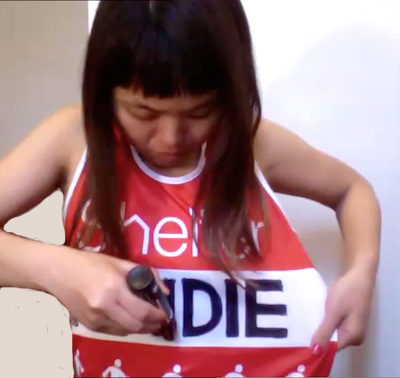
In a bid to save £1.67 for each alphabet (or £10 for 'K-a-i-d-i-e') we wanted to print on our Shelter running vest, we have gone IKEA and done a DIY (copying the Arial bold font - couldn't you tell!!!), with the assistance of a superfat marker purchased from Paperchase which says 'water-resistant' - although not 'sweat-resistant'! Hence, the letters may run as we run. Come what may, it's the point of no return. We will find out on 17 April at the 2011 Nondon Marathon.
RUNNING = LIVING = RUNNING. BUT WHEN WE HIT THE WALL MID-JOURNEY, HOW CAN WE FIND THE STAMINA TO COMPLETE IT?
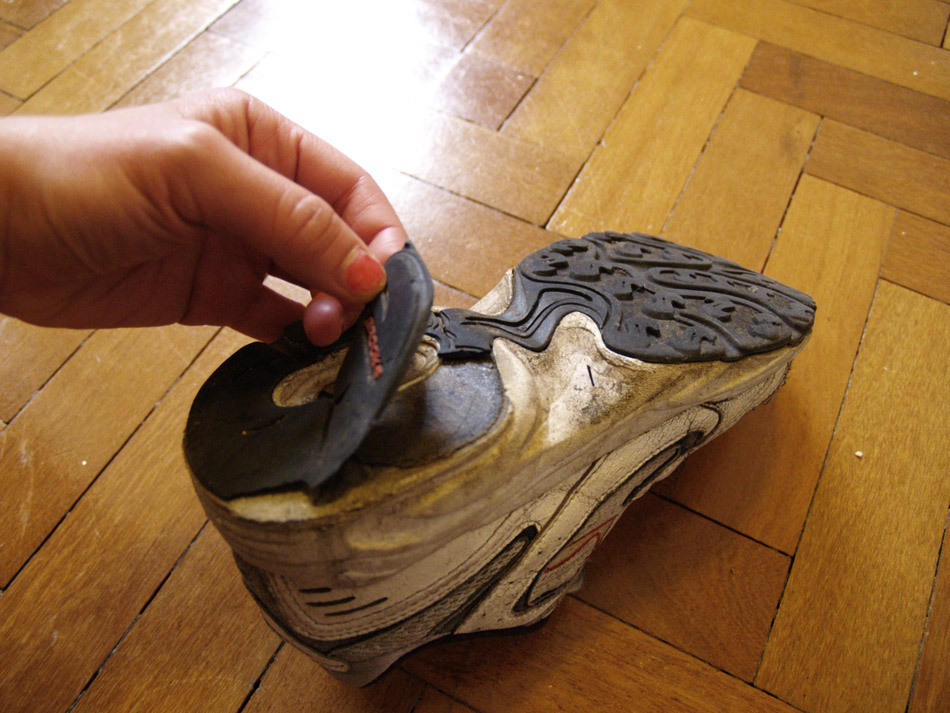
Broken. (Super-)Glued several times, but falling apart (looped, like a broken record, like living, like the cycles of life and death, like dying, like running, like running on quicksand, like running on slowsand, like not running, but running, still).
For me running is both exercise and a metaphor. Running day after day, piling up the races, bit by bit, I raise the bar, and by clearing each level I elevate myself. at least that’s why I put in effort day after day: to raise my own level. […] The point is whether or not I improved over yesterday. In long-distance running the only opponent you have to beat is yourself, the way you used to be.[1]
We journey forwards to the finishing line in a running session (or at the completion of a race, which is the epitome of a running session, with set rules and a clear beginning and closure). In life, we journey towards the finishing line of death. In the process, like writer Haruki Murakami, we desire improvement and progress in any given run, as we do in life itself. Yet, any long-distance runner also understands the dictum that when we run, we are essentially running against ourselves (and not our fellow runners). As Bernd Heinrich states of his record-breaking championship in the 1981 ultra-marathon, he was running it ‘all by myself, against myself’; ‘I’d done the best that I knew how at the time. That’s what mattered to me.’ [2] Contrary to the short distance sprint, the emphasis of the long-distance run is its process. Given the strenuous nature of running, pain and exhaustion are the Achilles heels of any runner, capable of literally and metaphorically bringing us to our knees. Especially in the case of ultra-running (of distances above 42km), it is when our body and mind are pushed so far that we are reminded of our limitation, vulnerability, and indeed, mortality. For Murakami, ‘learning something essential in life requires physical pain’ in most cases.[3] Yet, while ‘the hurt part is an unavoidable reality’, what matters is how we respond to this pain.[4] Thus, ‘[p]ain is inevitable. Suffering is optional’.[5].In bringing us close to death, pain is that which reminds us that we are alive. We run after pain because it reminds us of our mortality. An undertaking such as endurance running fulfils this basic instinct of ours. Like the endurance hunt, the race becomes a metaphor for life and death, except that instead of competing against the nimble antelope, we are fighting against ourselves, outrunning our own limitations. No stranger to pain, Murakami states that it is ‘precisely because of the pain, precisely because we want to overcome that pain, that we can get the feeling, […]of really being alive – or at least a partial sense of it.’[6] Hence, that which is at stake as we journey in the process of a run or life itself is how we respond to the ups and downs that confront us along the way. In another words, how we negotiate, manage and navigate our runs, and, indeed, our lives —which is the question that we are addressing in our thesis of Trans-dimensional Running For Our Lives! A Rough Guide to a Critical Strategy for our Technologically-Layered Multiverse .
In fact, Murakami’s What I Talk About When I Talk About Running can be read as a poetic discourse of the activity of running as a means to negotiate, manage and navigate his life and mortality itself.[7] Over a collection of essays, he discusses his peak as a runner (and writer), and contemplates about his own physical decline as a runner as he grows older.[8] In contrast to the image of a highly-successful novelist and athlete, the essays reveals Murakami as one ridden with anxieties and self-doubt about (his) existence. In tones not dissimilar to Antoine’s epiphanic laments in Jean-Paul Sartre’s existential textbook Nausea, Murakami ponders about whether he has overcome his ‘shortcomings’ as he ages (‘now here I am living in this unimaginable world’;[9] ‘wretched sort of feeling’;[10] ‘struck by how pitiful n pointless this little container called me is, what a lame, shabby being I am’;[11] ‘sad spreadsheet of my life that reveals how much my debts far outweigh my assets’[12]). In a particularly poignant (and humorous) passage, Murakami describes watching ‘young blonde girls’ swinging their ponytails ‘proudly’ as they run, and distils from it the metaphor of how ‘one generation takes over from the next’. He allows them to overtake him, for they have different sense of time, which is ‘the way it should be’.[13] For Murakami, ‘this is how the world is handed over in this world’. He continues to run his own run —and his own life— and comes to terms with (his) mortality:
[…] I doubt I’ll ever be able to run the way I used to. I’m ready to accept that. […] And time does its job much more faithfully, much more accurately, than I ever do. Ever since time began (when was that, I wonder?), it’s been moving ever forward without a moment’s rest. And one of the privileges given to those who’ve avoided dying young is the blessed right to grow old. The honour of physical decline is waiting, and you have to get used to that reality.[14]
[1] Haruki Murakami, What I Talk About When I Talk About Running (Random House Inc., 2009). p. 10.
[2] Bernd Heinrich, Why We Run: A Natural History, Reprint (Harper Perennial, 2002). p. 266.
[3] Murakami, p. 140.
[4] Murakami, p. vii.
[5] Murakami, p. vii.
[6] Murakami, p. 171.
[7] Thirty-three —which he notes was the age that Jesus Christ died and Scott Fitzgerald began to decline— was the age that Murakami picked up running (as well as his ‘belated, but real starting point as a novelist’). Murakami, p. 47.
[8] Murakami, p. 11.
[9] Murakami, p. 18.
[10] Murakami, p. 152.
[11] Murakami, p. 152.
[12] Murakami, p. 152.
[13] Murakami, p. 94.
[14] Murakami, p. 121.
30 DAYS TO RAISE THE FINAL £342 FOR OUR RUN FOR SHELTER AT THE 2011 NONDON MARATHON.

It costs £10 to print our name on the vest (£1.67 each alphabet!!) so at the meantime, we have printed our name digitally - free of charge!
Here we are in the Shelter vest that we will wear on 17 April Sunday at the 2011 Nondon Marathon. Thanks to the wonderfully generous support of 38 of you in the past 3 months, we have raised £1158 for the housing and homelessness charity. With your blackmail, we have been training steadily, clocking in 3 hours for 30km. That said, we may reach the destination at 1pm, which is 4 hours after we begin running the 42km, or Tuesday morning at 40 hours after we take off. In the next 30 days, we hope to raise our final £342. This afternoon, STEPHEN WARD, who sells fruits in front of the Goodge Street station and who is also a runner, very kindly donated £10 for our effort! THANK YOU STEPHEN!!
** As we run we try to make sense of what has just unfolded and is unfolding in Japan – and can not yet make sense of the scale of devastation. This was where we lived in a previous life for 3 years, and during when there were constant reminders of the preparation of ‘the big one’, along with countless drills. Yet, no rehearsal or preparation can help us come to terms with what the magnificent destruction. Let us also find ways to help and do what we can: click here to see how we can show our support. **
WHY RUNNING ALONE IS THE BEST/ONLY WAY TO RUN: Like Murakami, Turing and Colin, we run because we seek solitude. We are solitary beings; hence we run long distances. Go on, call us selfish.

We (prefer to) live, run and die alone: in the plastic dustbin of history. Nonetheless, nice to meet you. Nice to have met you. Nice meeting you. WC1 Nondon Spring 2011.
The narrative of human beings is (or, we should say ‘the narratives of human beings are’) populated / infested by wandering hermits – St Jerome, Anthony of Egypt, Basho, Jesus Christ, Lao Zi, Buddha, Confucius, Mencius, Chatwin, are but some of the named itinerants who have been recorded and mythologised, and have captured our imagination. There have been many more unnamed. As they traversed the world(s), they meditated, wrote, spoke, sang and came to terms with their being, in one way or another. (Or not – and spend their lives making tours and detours, making false moves and dying pathetically, rotten, sickly, unenlightened, bitter, as sickbags, like the rest of us). To be sure, the story of mankind (which sounds rather grand, does it not?) is also populated by the gregarious, the socially-adept, those who prefer direct action, so on, and so forth. Which is exactly the/our point – the so on and so forth-ness of things – that there are different paths each prefers. Each of us has different means of getting there; each of us has different paths that works for us. We respect yours, and you, presumably, ours. When we cross paths and run into each other, we may fight, have a tussle, a tumble, or two, or more, a war, civil, or uncivilised, or cold, or silent, or ongoing and unresolved. Or, we may sparkle, together, shine, tango constructively and powerfully, like the clash of civilisations, meeting of 2 different chemicals to produce a third, new, synthetic (in all meanings of this word) possibility. Or, more mundanely, it is the combination of the above 2: a process, of a mixture of curiosity and argument, debates and agreements, hits and misses, fall outs and make ups, negotiation and mediation (‘compromise’ is a word we loathe, for it is less constructive but a giving-in, a weakening. The best, or rather ‘best’ encounters are not weakenings, but processes of strengthening. In the ideal world). At the meantime, we blame each other for intruding into our lives, as we confusedly try to work it out, yet, also, perhaps, at the back of our minds understand/believe that something interesting, something larger than each of us alone, something more wonderful and further than what each alone can achieve or where each could travel/go. Hence we work on it. Or not, should we run out of stamina. (Or faith? If there is such a thing, that is! Baaaaaaaaaaaaaaaaaaaaah.)
Screw this – this thread sounds romantic, old-fashioned, esoteric, irrelevant and plain silly.
Enough rambling.
Let us get back on track.
Restart (contemporarised, main-streamified):
The nature of long-distance running over hours and hours almost demands that it is a solo undertaking. For world champion marathon runner Paula Radcliffe, while there are times when running can be ‘a big social thing – go for a run, catch up with friends and have a really good chat’,[1] running for her remains a primarily solitary activity, ‘during which I just […] have my time.’[2] To be sure, we can run with pace-makers or pacers, whose task is support runners to ensure that we are not over- or under-exerting ourselves. In particularly demanding races such as ultra-marathons, during which runners can become so exhausted as to encounter hallucinations or lose consciousness, such collaborations can be a matter of life and death. As Christopher McDougall says, ‘a tough pacer can save your race; a sharp one can save your life’.[3] Yet, the writer and ultra-marathoner also refer to pace-makers condescendingly as ‘mules’, adding that ‘[p]acing is so gruelling and thankless that only family, fools and damn good friends let themselves get talked into it.’[4] Hence, if we wish to make (sporty) new friends, the conditions circumscribed by activities such as soccer, aqua-aerobics or the physically-gentler activity of walking seem more promising.
The solitary nature of long distance running in Life 1.0 is epitomised in (and mythologised by) the title of the book and film, The Loneliness of the Long Distance Runner. In this ‘Kitchen Sink’ classic[5] written by Alan Sillitoe in 1959, it is during our protagonist Colin’s solo runs that he is able to have ‘his time’, away from the physical, emotional and economical confines of his reality, including the Borstal prison to which he was confined to. Indeed, running was said to have been the ideal activity for Alan Turing, as it mirrored the loneliness of his journey as a scientist.[6] Given that such intellectual and creative work demands intense concentration, there are scientists as well as artists who may prefer working in isolation. (That said, there are clearly many who prefer to work collaboratively.) (Clearly, too, is that there are not so many artists who undertake endurance sports, apart from enduring many hours of debauchery, which we excel in as well). The same intensity required of a scientist’s creative process is not dissimilar to that of an artist or writer. As a matter of fact, novelist and marathon runner Haruki Murakami admits that he actively seeks out solitude, and grants that ‘especially for someone in my line of work, solitude is, more or less, an inevitable circumstance.’[7] Running suits him perfectly, as ‘[a]ll you need is a pair of running shoes and you can do it anywhere. It does not require anybody to do it with […].[8] He adds:
I’m the type of person who doesn’t find it painful to be alone. I find spending an hour or two everyday running alone, not speaking to anyone, we well as four or five hours alone at my desk, to be neither difficult nor boring. [9]
This is our chosen way of life. This is how we run (navigate, negotiate and manage) the/our world(s). We are neither Buddha nor Jesus (in case you didn’t know), but Christ!, to each her own. Just as there are those who prefer to travel alone, there are those who love it communal; just as there are lonely long-distance runners, there are sprinters who fear loneliness (and then of course, there are those who prefer other modes of locomotion to running, and then those who prefer not to move at all. Which is all fine. We say ‘fine’, though it is of course not up to us really. Not at all. Nor do we bother, though our job is to spread the gospel of our world-shattering thesis of trans-dimensional running, which is what we have been going on and on about, though of course, that is an other story, and we may not want to go into that again, not just now, any ways. Which we ourselves are getting extremely tired of as well. In any case – which ever ways. What we want to say is, at the end of the day, to each her own).
Go on, call us selfish. Like it or not, we are moving on. Take it. Leave it. Which ever. May we cross paths again. Or maybe not. See you later. If ever.
[1] Patrick Barkham, ‘Patrick Barkham Goes Running with Paula Radcliffe’, The Guardian, 16 December 2008, section Life and style <http://www.guardian.co.uk/sport/2008/dec/16/paula-radcliffe> [accessed 25 September 2010].
[2] Barkham.
[3] Christopher McDougall, Born to Run: The Hidden Tribe, the Ultra-Runners, and the Greatest Race the World Has Never Seen (Profile Books, 2010), p. 88.
[4] McDougall, p. 89.
[5] The Kitchen Sink genre refers to the British cultural movement of the 1950s-60s. The social-realist works, created by filmmakers and writers called ‘Angry Young Men’, are anti-Romantic, often featuring (anti-)heroes of the working class who are anti-establishment. ‘Author Alan Sillitoe Dies Aged 82’, BBC, 25 April 2010, section Entertainment <http://news.bbc.co.uk/1/hi/uk/8642720.stm> [accessed 31 October 2010].
[6] Anish Chandy, ‘Alan Turing Biography’, Buzzle.com <http://www.buzzle.com/editorials/4-5-2005-68126.asp> [accessed 12 July 2010].
[7] Like Murakami, Turing was also known to be a loner, although it could be argued also that this is in part due to his inability to live as he wished because of his sexual orientation (homosexuality being a crime in the 1950s in the United Kingdom).
[8] Yishane Lee, ‘Haruki Murakami Interview from Runner’s World.com’, 2004 <http://www.runnersworld.com/article/0,7120,s6-243-297–8908-0,00.html> [accessed 26 September 2010].
[9] Haruki Murakami, What I Talk About When I Talk About Running, Reprint (Harvill Secker, 2008), p. 15.
Mathematically-speaking, we SHOULD take 4 hours to run 42.1km. Non-mathematically-speaking, we may take 40 hours.
How long will we take to complete 42.2km at the Nondon Marathon on 17 April 2011? We will finish, by hook or by crook or by crawling. But the million-pound (or £1500) question is, in what time? To be sure, every run is different, and every race – a particular competitive run session with a specific start and finish across a set route; a heightened run session – comes with its own sets of quirks. The variables are infinite (climate, route, scenery, traffic, fellow runners, clothes we wear, if the race is well-sign-posted, audience/spectator-support, number of yummmmmyyyyy jelly-babies [and Snicker bars] we manage to pop into our mouth en route at feeding stations, et al), but we can begin by examining our running and race history: (Go ahead and mock, spit, laugh at us, but you would have realised by now that we are painfully slow coaches, such slow runners we are that we are probably better off walking, but at least we have lasting power for the endurance race of our lifetimes…)
1) 2010 March: 10km race by the Friends of Medicin Sans Frontieres Nondon: This was an easy race of 10km which we completed in 52 minutes, which works out to be a speed of 11.54km per hour (or 7.17 miles per hour), or a pace of 5 minutes 12seconds for every 1km (0.822 minutes per mile) It began as a crisp early Spring morning but turned 8 degree celsius, so we were dressed in short-sleeved and long tights, although we were carrying the burden of stomach cramps (!!! TMI !!!). In this race, we raised money for the Medecins Sans Frontieres. We had been kidnapped before the run, was released on time by The Good Pirate.
2) 2010 September: 42.2km: Farnham Pilgrims’ Marathon, Surrey. This was our first ever full marathon, which we ‘accomplished’ (sic) in a disgraceful 5 hours 29 minutes! We have plenty of excuses, however: 1) it was off-road in a hilly terrain – we stopped to WALK at a steep hill climb at a point (it was said that most runners had to add 30 minutes to any of their times for this race) 2) We had spent the entire summer running all over Nondon, in a bid to train for our first ever marathon. However, in the final 2 months, we were brought down by injury (tendonitis and shin splint), which came with us to Farnham. Yet we do not fret, and were delighted to have completed the race. All in all, it was a most wonderful experience, against the gorgeous and meaningful mise-en-scene that the pilgrims had once walked, the fellow runners a tremendous joy to be with, and beautifully organised. We also raised a weeeee bit of money for the Farnham hospices.
3) In a previous life: 2009 August, Singapore, 21km (13.1 miles) SAFRA Bay Run Half-Marathon: This was our first ever race since casually picking up running in January 2009 in a previous life, at the same time of still being chlorine addicts. We took 2 hours 21 minutes – which is the amount of time taken by the world’s elite runners to complete FULL marathons!! However, we were not displeased, with the high humidity, and at 30 degree-celsius of the (paradisal) tropics. We are proud however of the fact that in our final 4km sprint, we managed to bypass 655 men and women (and yes, allowed 20 to bypass us). Running alongside more than 20,000 people of all size, shape, age and colour was also tremendously enjoyable. By default, happiness and pleasure are inevitably short-lived- but our entire 2 hours 21 minutes was a skyrocketing morphine-high. It was an extraordinary trip.
So. How on (google)earth would we fare on 17 April 2011?
1) For the first / last 450 days of our lives, we have been working hard at our running. Outside of a race, our comfortable pace is approximately 10kmh – 10.5kmh. At this pace, there is neither exertion nor discomfort. (Under artificial conditions, inside the gym, our average is around 10.5kmh – 12kmh, though this figure we should ignore, since it is climate-controlled, and we are running on machines that move nowhere, hence using different muscles of our body. The psychology of such locomotion differs from that outdoors as well)
2) Since February, we have been training longer distances (20km and above), but our fourth toe on our right feet has been harvesting a blister (!!! TMI !!!) This has never happened previously so we are slightly worried, wondering if we should go ahead and buy a new pair of shoes of a slightly larger size. Yet, already armed with three pairs of trainers, we do not want to buy another pair right now. Then there is also a new bone-like thing sticking out of our left feet recently, that prevents us from wearing any shoe without feeling pain. (!!! TMI !!!) Again this is new, and did not happen in our Summer training.
3) The past year of running means that our technique would have improved, but at the same time, we are aging as we speak. We are juvenile at 430-days-old, but because we have only 1000 days in our lifespan, we are nearly middle-aged. While we come with the charms and beauties of a mature wine and even more mature blue cheese (as well as iron-will power, truckloads of stubbornness, and plenty of drive), we might not win a spring chicken in a photo-finish. We will come back to this issue of running and mortality in a separate post.
4) As anybody knows, there’s such a silly law called the law of diminishing returns. Whichever sillier eejit came up with it, we have no idea, but when it comes to a slowburning, longhaul endeavour as a long-distance run, no one is sparred from this law. We can get increasingly worn out and deriving less and less satisfaction from the run over hours and distances. And from experience, we know that we are excellent practitioners of the law. This can translate what should take 4 hours into to a pathetic epic 5 hours (first 10km takes 1 hour, because we are warming up and do not want to over-exert; for the next 10 km we dip a little, as we are still conserving our energy at 1 hour 10 minutes; then the 30th km takes 1 hour 20 minutes, and for the final 12km, we have the sudden epiphany that we have to get our arses moving, and hasten a little but alas it is too late as our glycogen-levels would have deteriorated so we complete it in 1 hour 30 minutes).
So there we have it. On 17 February Sunday, we may take anything from 4 hours, or, 40 hours.
But let us think of positive thoughts. Next year, in our final year of existence, we would like to sign up for the midnight sun run in Norway. How beautiful and hyperreal an experience it would be. And, with all that sunlight one cannot possibly sleep anyways, so why not go for a run. For a few hours, the duration of a sleep. We currently devote about 8 hours of exercise each week (at least an hour a day); training for a marathon means a minimum of 10 hours or exercise each week. We must not neglect our run in other dimensions, so this running about in Life 1.0 may be taking up just too much time. We decide that the half is the best distance for us, also since we can sustain happiness for a maximum of 2 hours at any one go. Anything beyond that, at 4-5 hours for instance, the law of diminishing return sets in and the dreaded dip, the hitting-of-wall happens. 10km races are too fast/short. Hence, we intend to take part in the 2012 Bath Half Marathon. With a companion.
We go to bed and dream our recurrent dream of riding the Trans-Siberian, in loops. We wake up, in cold sweat, to (another) new year. Livid, we run a deliriouscatharticmadloop in a myopicdarkness at our favourite Regents Fark at 6am. We only begin to calm down with the words of Bruce Chatwin:
One afternoon in the early 70s, in Paris, I went to see the architect and designer Eileen Gray, who at the age of ninety-three thought nothing of a fourteen-hour working day. She lived in the rue Bonarparte, and in her salon hung a map of Patagonia, which she had painted in gouache.
‘Ive always wanted to go there,’ I said. ‘So have I,’ she added. ‘Go there for me.’ I went. I cabled Sunday Times: ‘Have Gone to Patagonia’. In my rucksack I took Mandelstam’s Journey to Armenia and Hemingway’s In Our Time. Six months later I came back with the bones of a book that, this time, did get published. While stringing its sentences together, I thought that telling stories was the only conceivable occupation for a superfluous person such as myself. I am older and a bit stiffer, and I am thinking of settling down. Eileen Gray’s map now hangs in my apartment. But the future is tentative.
Bruce Chatwin, ‘I Always Wanted to go to Patagonia’, 1983, in Anatomy of Restlessness, Viking, 1996, p. 13.

